This is an in-depth beginner’s guide to homemade French macarons. This post includes a kitchen-tested recipe, plus plenty of success tips, descriptions, overview of techniques, list of tools, and links to my favorite macaron resources and other recipes on the web.
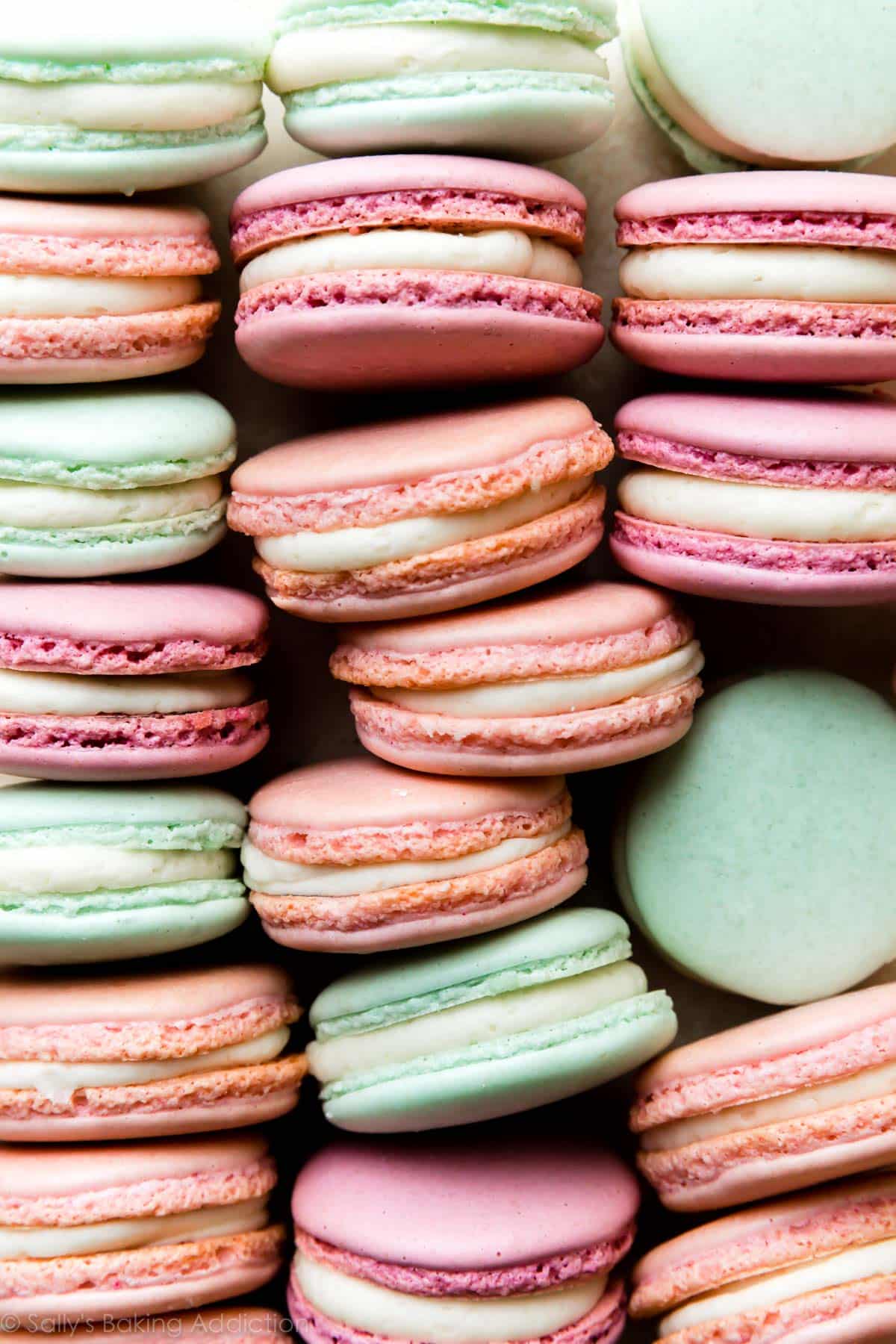
Let me start today’s tutorial with the following:
- Is this the one and only way to make French macarons? No.
- Is this the most complete, perfect French macaron tutorial out there? No.
- Is this a great place for macaron beginners? Yes.
Like many home bakers, I was a French macaron beginner a few years ago. These beautiful little cookies had always been a baking bucket list recipe for me. I started baking them after tasting the world famous Ladurée bakery macarons—talk about perfection! We originally published a French macaron recipe on my website in 2015. My homemade macarons weren’t nearly as flawless as the professional ones, but they worked for me at the time! However, the results weren’t always consistent. With 6 additional years of practice, I found a few small but very helpful improvements. Today’s recipe includes those updates.
Macaroons Are Not Macarons
Macarons and macaroons are two completely different cookies. Macaroons have an extra O in the name and are coconut cookies. Macarons are delicate sandwich cookies. Here are my coconut macaroons. See the difference? Though they are both cookies made with egg whites, they are much different.
They are both, however, gluten free dessert recipes.
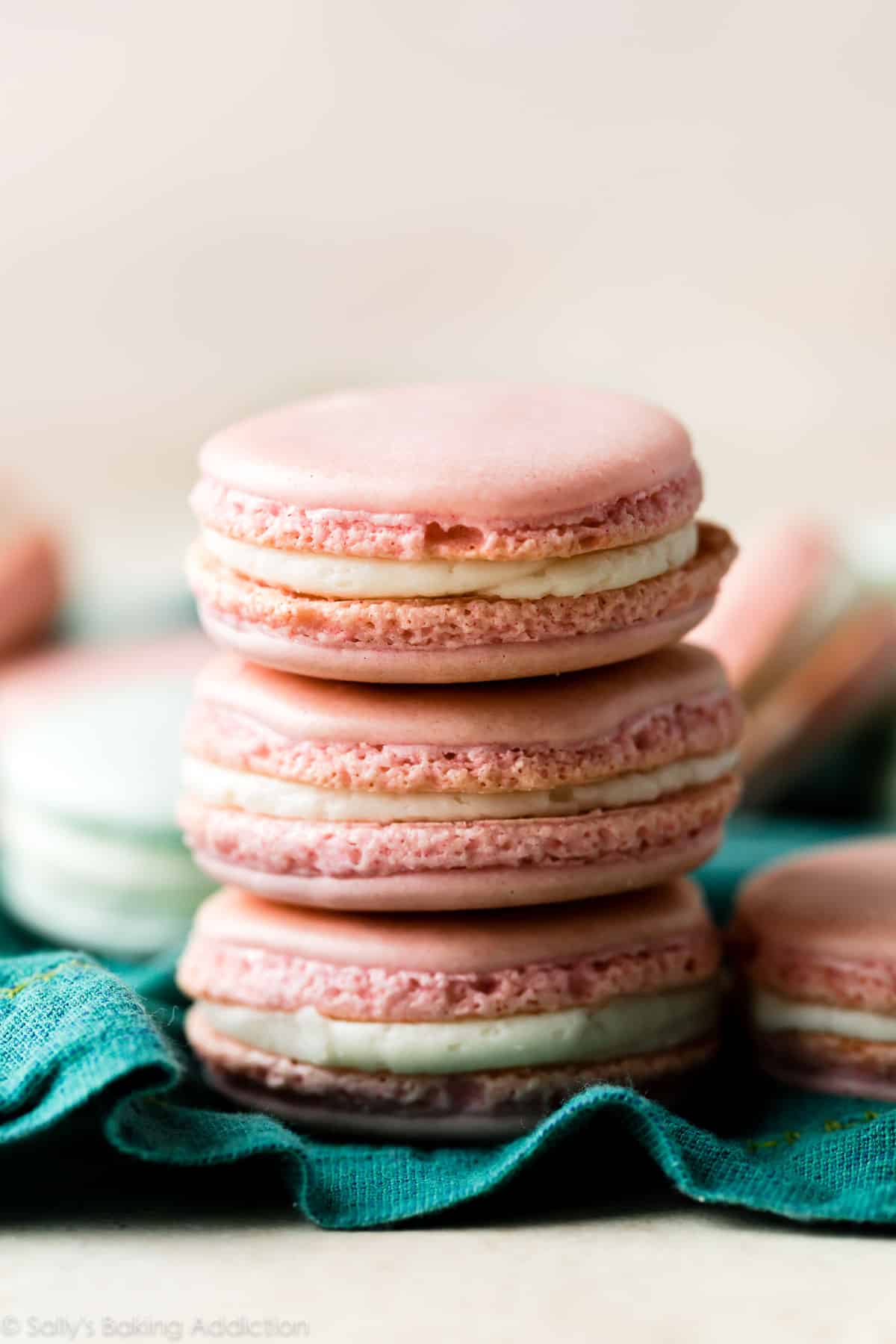
What Do These French Macarons Taste Like?
French macarons are delicate sandwich cookies with a crisp exterior. Each individual cookie is known as a macaron shell. The shells are made without any chemical leaveners and get all of their lift from properly beaten egg whites. If you follow the recipe carefully, the cookies have a unique nougat-like, chewy texture. They should not be hollow. You can flavor macarons many ways, but this recipe is for plain macarons. They taste like sweet almond—and they’re delicious! You can always have fun with different flavorful fillings such as vanilla buttercream, lemon buttercream, salted caramel, or chocolate ganache.
If there’s one thing to know before baking French macarons at home, it’s this: these cookies require precision, patience, and practice. I’m going to do my best to prepare any French macaron beginner. You can do this!
There are a few methods for making macarons including Italian, French, and Swiss. Swiss isn’t as common (I’ve never made them that way), but Italian macarons are pretty popular. The process is a little more involved than the French method, but the results are considered more reliable. If you’re looking for a recommendation, I really like these Italian macarons found on Chelsweets.
Today’s recipe uses the French method. You need 5 ingredients.
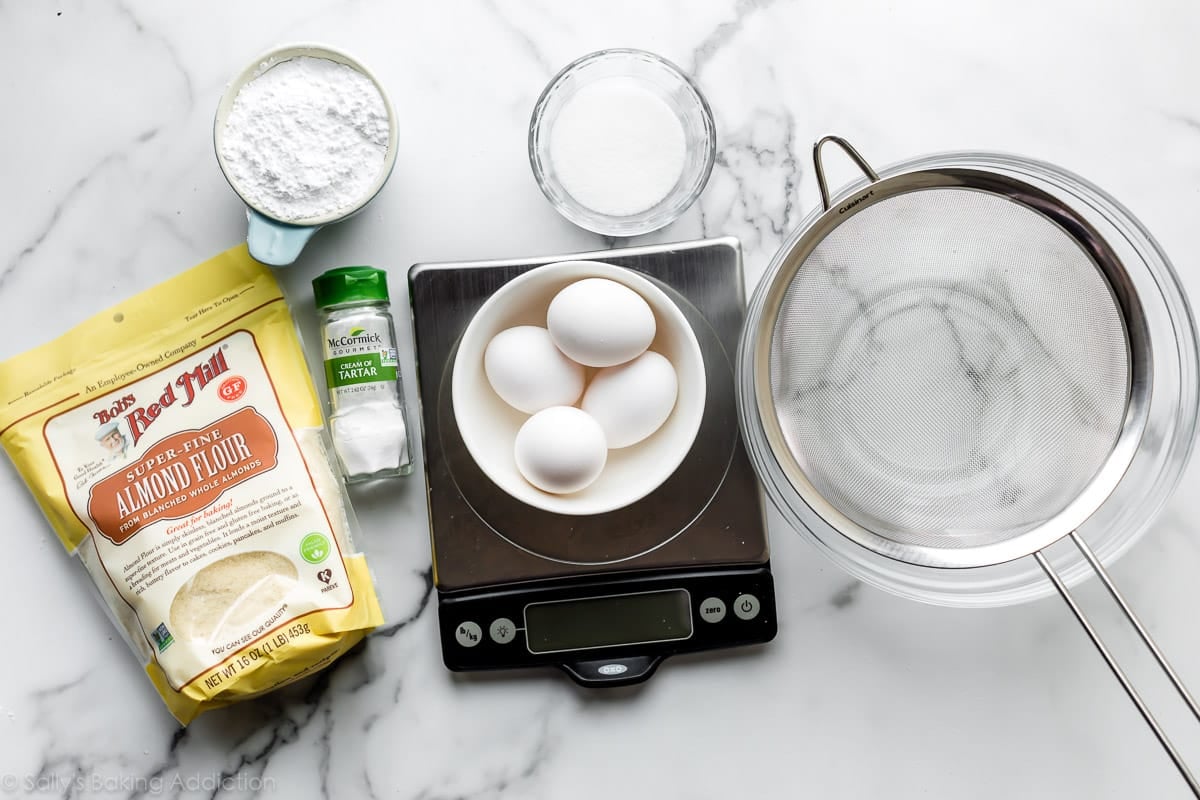
Overview of Ingredients in French Macarons
EGG WHITES: The bulk of French macaron batter is meringue made from properly beaten egg whites. For best and most consistent results, I strongly recommend using fresh egg whites instead of liquid egg whites from a carton. It’s imperative that NO egg yolks make it into the recipe. Like I taught you in our Swiss meringue buttercream recipe, any fat (yolk) in the egg whites will prevent them from reaching stiff peaks, a crucial step for the successful outcome in any French macaron recipe.
- Age The Egg Whites: It’s helpful to “age” the egg whites in the refrigerator for at least 24 hours prior to starting this recipe. Why? Egg whites that have been separated and set aside in advance have a chance to relax, which improves their elasticity during the whipping process. Elasticity is certainly beneficial when you’re trying to whip egg whites into a lofty volume. Some bakers skip this step, saying that it’s a waste of time but I’ll tell you this: most of my failed macaron batches did not include aged egg whites. I recommend taking the 5-10 minutes to separate your egg whites, cover, and refrigerate them 1 day in advance. It doesn’t hurt. Bring them to room temperature before you begin the recipe.
CREAM OF TARTAR: My old recipe doesn’t include this ingredient, but I started adding it after I began making successful batches of marshmallow meringue frosting and chocolate swirled meringue cookies. It just provides a little extra insurance. Let me explain: the acidity in cream of tartar helps the egg whites hold onto air and, like the sugar (explained next), helps prevent the egg whites from collapsing. If you’re making snickerdoodles or angel food cake, you already have this ingredient on hand. It’s sold with the spices.
SUPERFINE SUGAR: In 3 additions, beat superfine sugar into the egg whites + cream of tartar. Without sugar, the protein molecules in egg whites will collapse. What is superfine sugar? Well, it’s regular granulated sugar that’s ground much finer, but not quite as fine as confectioners’ sugar. It’s also known as caster sugar. Superfine sugar’s granules are the best size to provide optimal structure for French macarons. Granulated sugar is simply too coarse, while confectioners’ sugar dissolves too quickly in the egg whites.
- I have a hard time finding superfine sugar in my local grocery store, so I make my own by pulsing regular granulated sugar in a food processor or blender. It takes about 10 seconds—very easy.
FINE ALMOND FLOUR: Almond flour is the ONLY flour that works in this French macaron recipe, however if you have an almond allergy, you could try these nut free macarons by Stella Parks. (I have not personally tried them.) Make sure you use almond flour, not almond meal. Almond flour is much finer and made from blanched, skinless almonds. Almond meal is coarser and contains almond skin.
- You can make your own almond flour, but be very careful because almonds can quickly release their oils, clump up, and turn into almond butter. It might be easier to just pick up a bag of fine almond flour. It’s very common in mostly all grocery stores these days—I use and love Bob’s Red Mill brand.
CONFECTIONERS’ SUGAR: Confectioners’ sugar adds bulk and sweetness to macaron batter. In this new recipe, I use equal parts confectioners’ sugar and almond flour to produce sturdy, more reliably successful macarons.
GEL FOOD COLORING (optional): Tinting macaron batter is completely optional. If you don’t tint it, the macarons will be a natural beige color. (And you can have fun with a colorful filling.) Avoid using liquid food coloring because it will change the consistency of your macaron batter. Instead, use 1-2 drops of gel food coloring.
- In the pictured macarons, I made 3 separate batches and used dusty rose, aqua, and fuchsia.
- Powder food coloring should be fine, but I haven’t tested it. Use a very small amount.
Crucial Tools
This list contains affiliate links to the products we personally use and love.
- Glass or Metal Bowls: Plastic bowls are porous and can hold onto grease and residue, which will prevent your egg whites from whipping properly. Set yourself up for success by using glass bowls or metal bowls in this recipe.
- Egg Separator: Not crucial, but certainly helpful. Here is the egg separator I really like.
- Food Scale: The recipe below is written in grams, so a food scale is imperative. Anytime I make macarons using cup measurements, they fail. You can certainly find French macaron recipes online given in cup measurements, but for true accuracy (and so you don’t waste your time, effort, ingredients, or money), I strongly recommend using a food scale. Here is the one I own and love.
- Electric Mixer: An electric mixer is helpful for whipping the egg whites into stiff peaks. You can use a handheld or stand mixer (whisk attachment). I do not recommend whipping egg whites by hand. It requires a lot of arm muscle and at least 30+ minutes of mixing.
- Fine Mesh Sieve: To obtain a shiny and smooth macaron shell, you must run the almond flour and confectioners’ sugar through a fine mesh sieve. You can use a hand crank sifter if you have one, but I prefer using a mesh one.
- Piping Tip & Bag: You need a piping bag and tip to pipe the batter. You can use a disposable piping bag or reusable piping bag. (I use and love this reusable piping bag.) For the piping tip, use a round tip such as Wilton 12, Wilton 1A, or even Ateco 806. I use the same piping tip to pipe the filling, too.
- Baking Sheet & Liner: I own, love, and swear by these half sheet pans for baking all my cookies: Calphalon rimmed baking sheets and USA Pan half sheet pan. See more of my recommended baking pans on my Best Baking Pans page. It’s important to line your pan. You can use a silicone baking mat, parchment paper, or even a fancy macaron-specific silicone baking mat. I usually use sheets of parchment paper.
Video Tutorial:
Step-By-Step Photos: How to Make French Macarons
Do your prep work. This includes (1) making superfine sugar with a food processor if you can’t find it at the store. I always make my own—see recipe note. Prep work also includes (2) wiping down the bowl you’ll whip the egg whites in with vinegar or lemon juice. Grease or fat prevents your meringue from setting up. And finally, (3) age your egg whites as described above and in the printable recipe below.
Making superfine sugar:
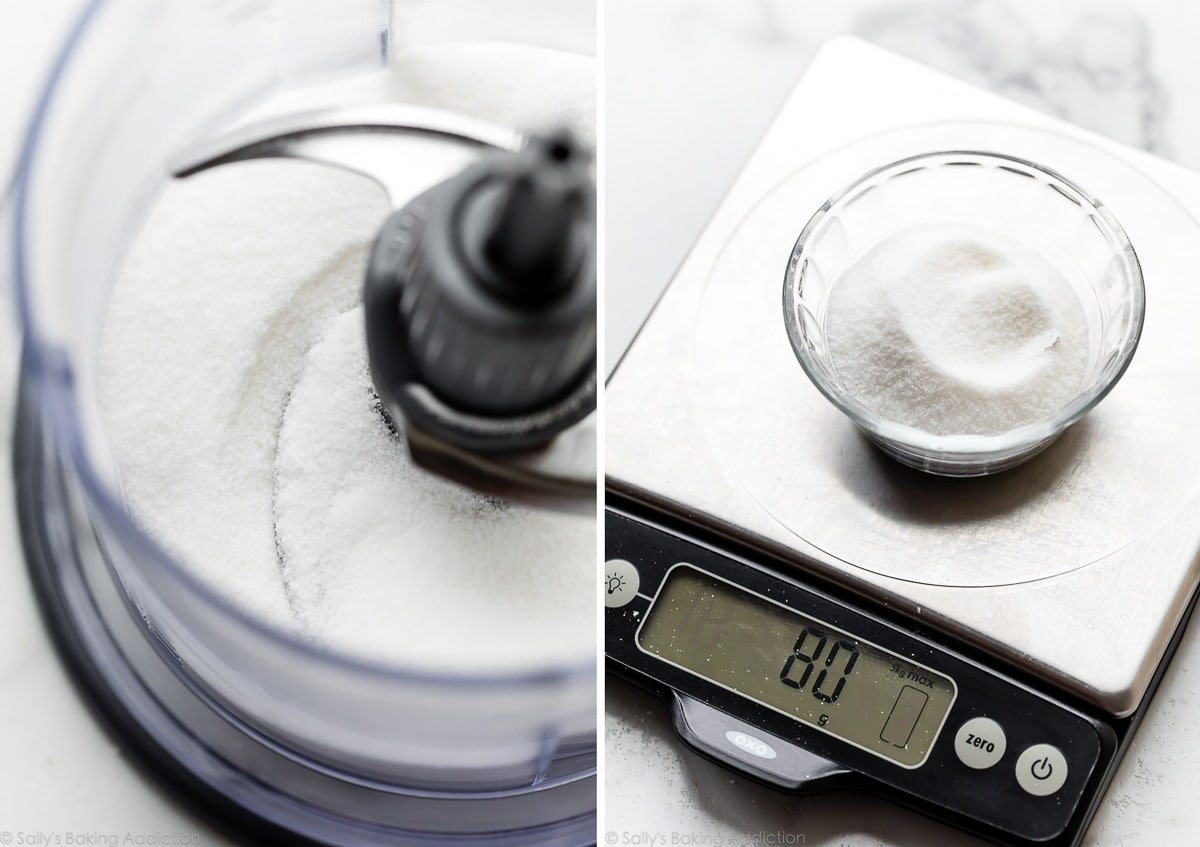
Zero out your scale, weigh your egg whites, cover, and refrigerate them for 24 hours. Bring to room temperature before using.
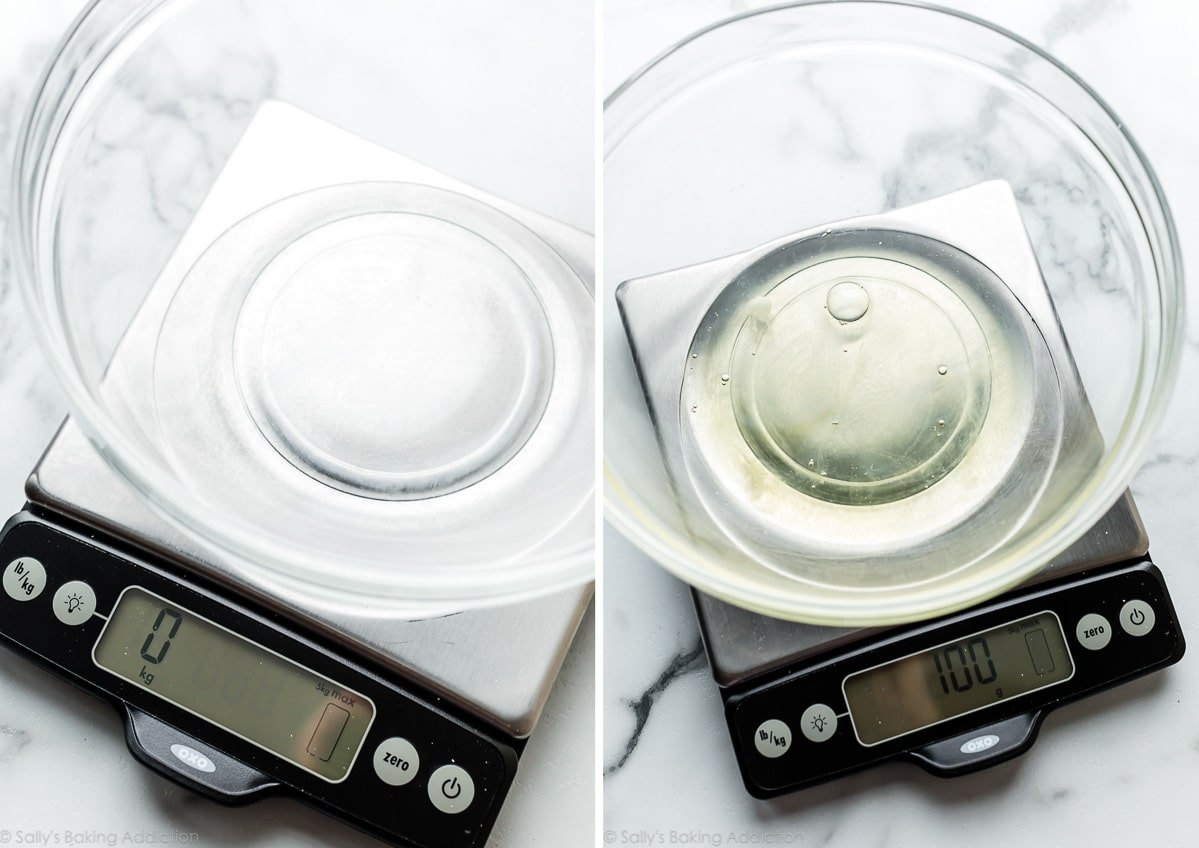
Now it’s time to start the macaron batter.
Add cream of tartar to your aged room temperature egg whites (below left) and beat until very soft peaks form. This takes a few minutes of beating. At first the egg white and cream of tartar mixture will be foamy, then the bubbles will begin to tighten and the beaters will leave tracks (below right) as the egg whites build volume:
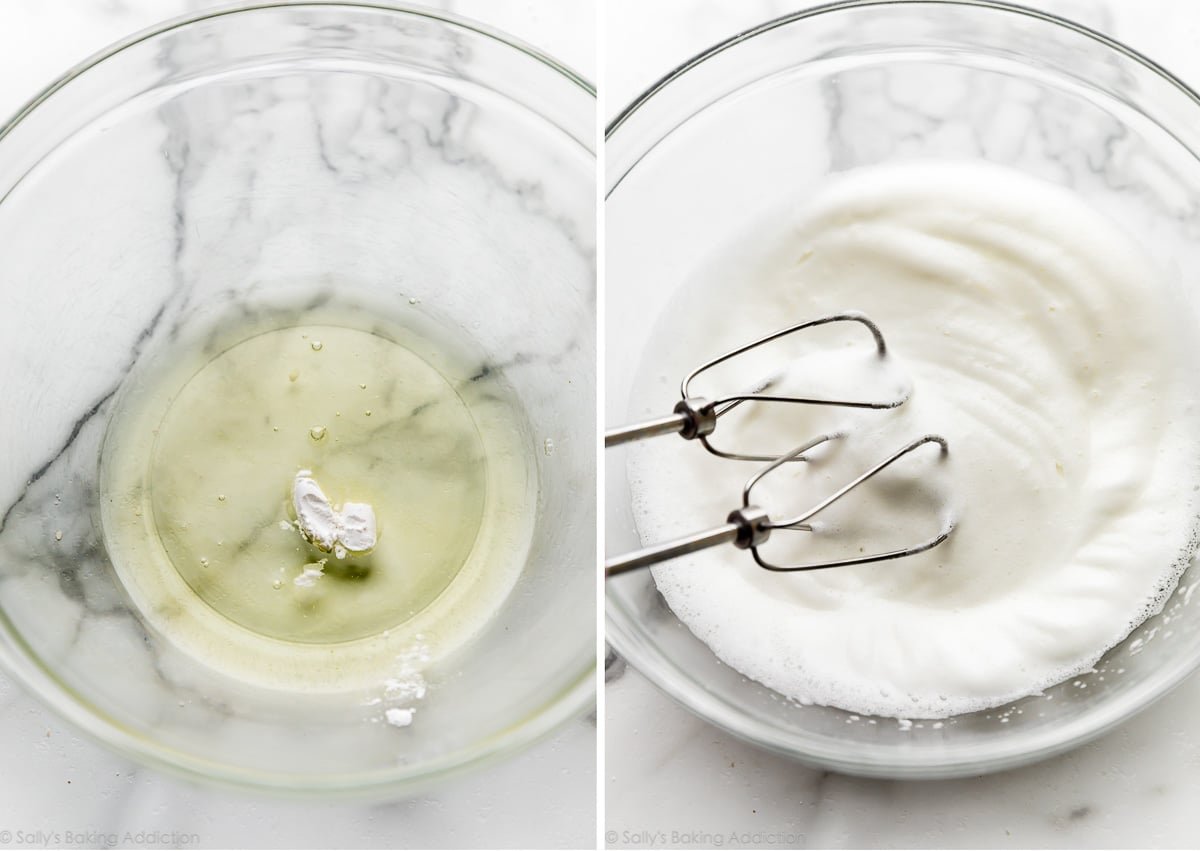
Now add your superfine sugar in 3 additions and beat until stiff glossy peaks form (below photos). What are stiff peaks? After several minutes of mixing in all the sugar, the egg whites will form stiff glossy peaks. This means the whites have stiff, smooth, and sharp points in the bowl or on the lifted whisk attachment/beaters. Stiff peaks do not droop down. You can literally turn the bowl upside down and the egg whites will not move or spill out. (You can watch me do that in the video tutorial.)
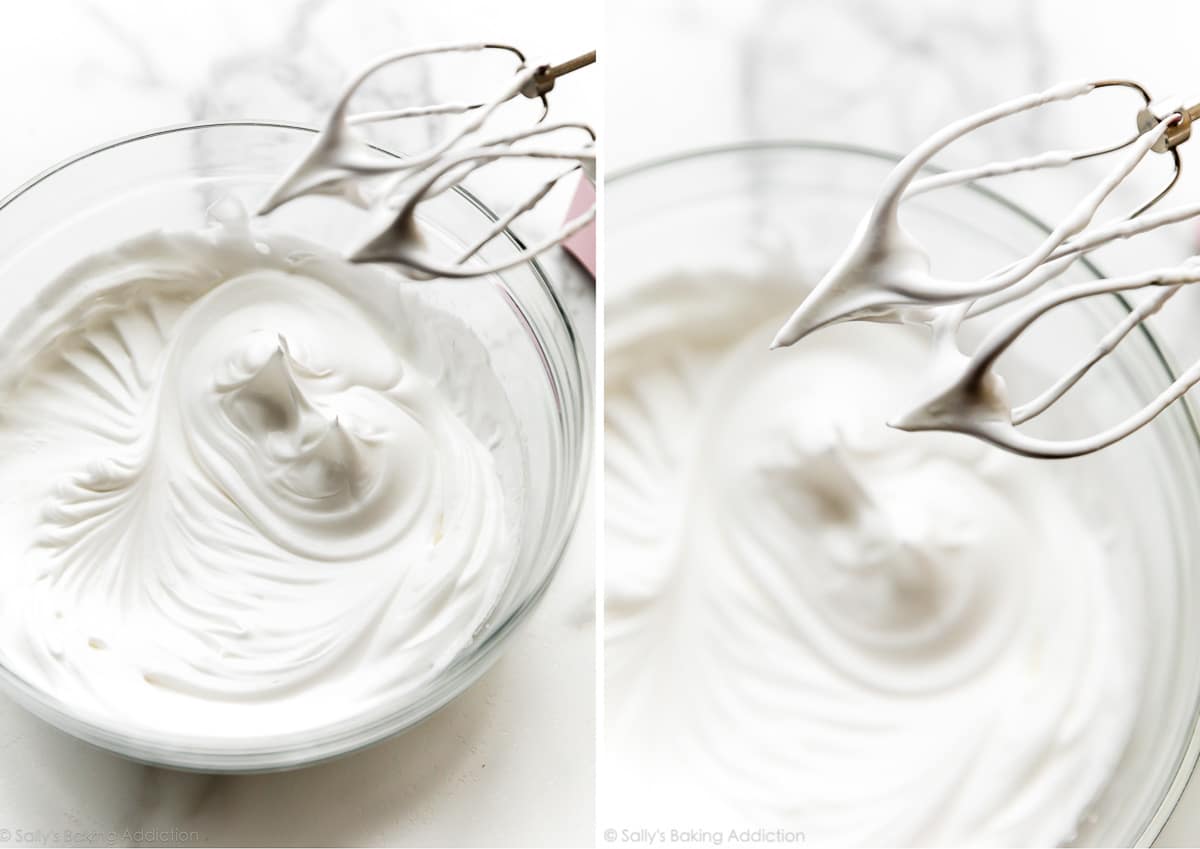
Now you can add your optional gel food coloring. It’s important to add gel food coloring to the egg whites directly, instead of the finished macaron batter. (Finished macaron batter more easily deflates.) Fold the coloring in very slowly. You can also beat in the food coloring with your mixer on a low speed.
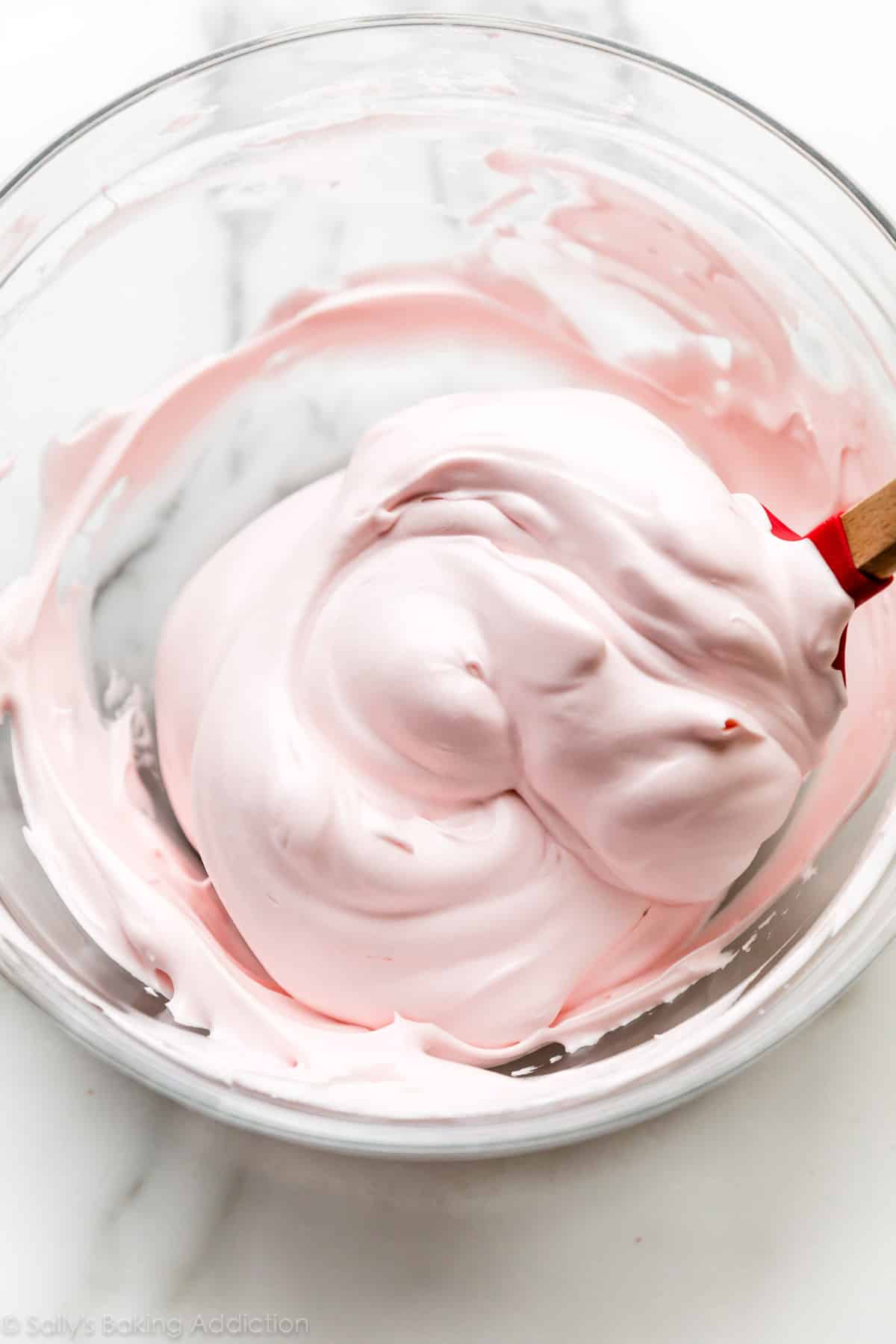
Set your stiff egg whites aside.
Sift the almond flour and confectioners’ sugar together in a large bowl. The bigger the bowl, the more room you have for the macaron batter, and the easier it will be to manage. Use a spoon to help work any larger pieces through the sieve. You don’t want to discard a lot of that because then you won’t have enough dry ingredients in the batter.
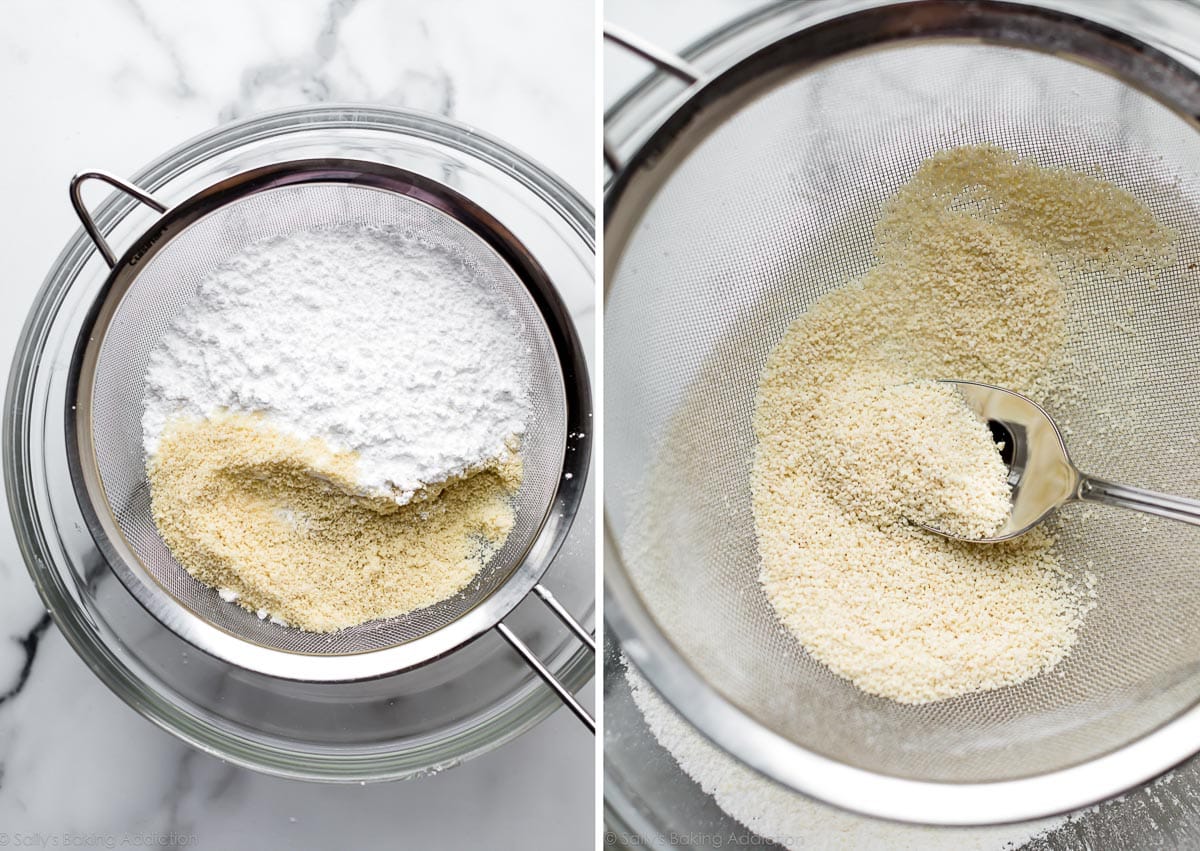
Sifting guarantees a nice light texture.
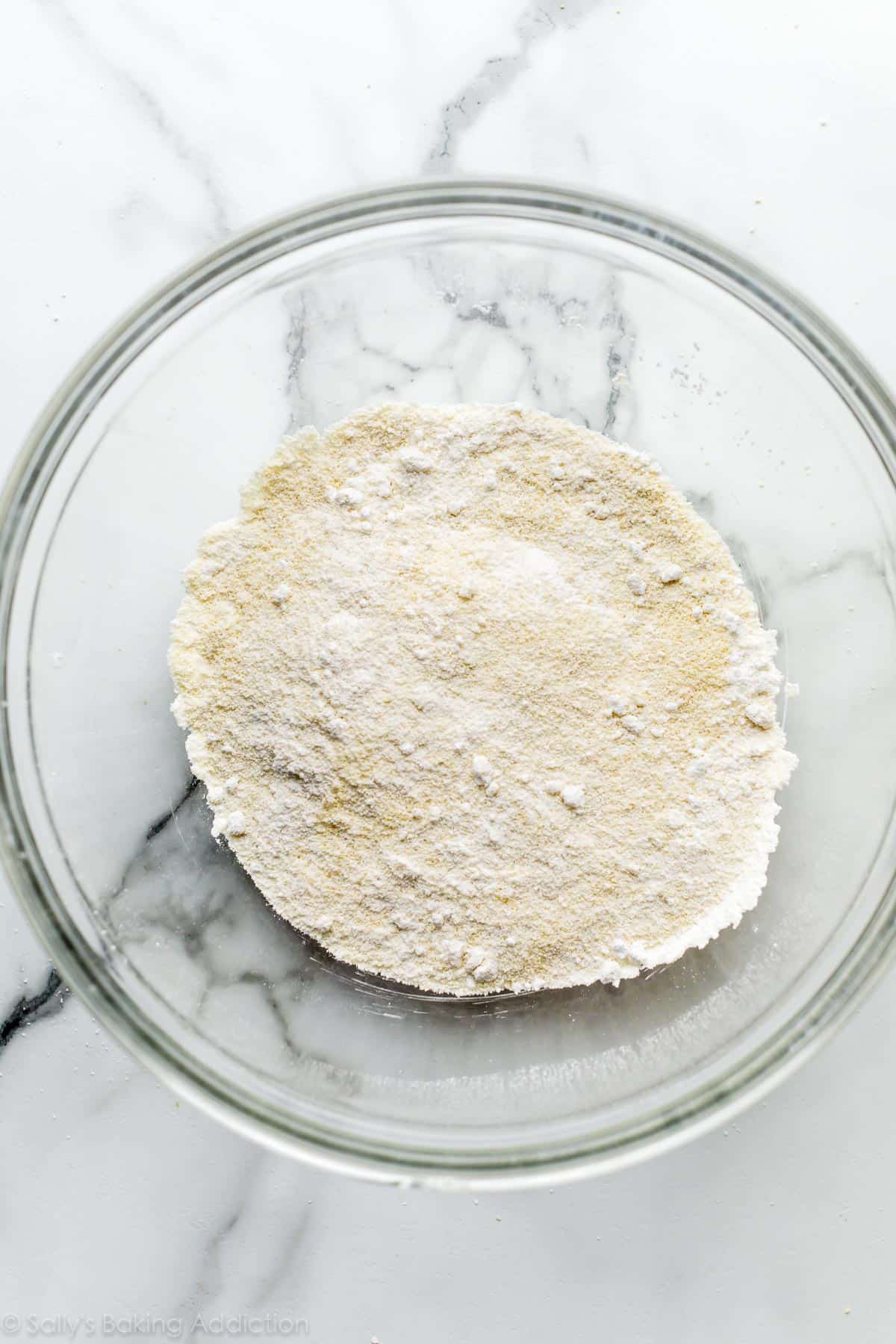
In 3 separate additions, begin slowly folding in the beaten egg whites in a circular motion. I always eyeball the amount. (Tip: The amount of egg whites you add at a time doesn’t have to be perfect because what you’re really looking for is the consistency of batter after the 3rd addition, known as macaronage and explained below.)
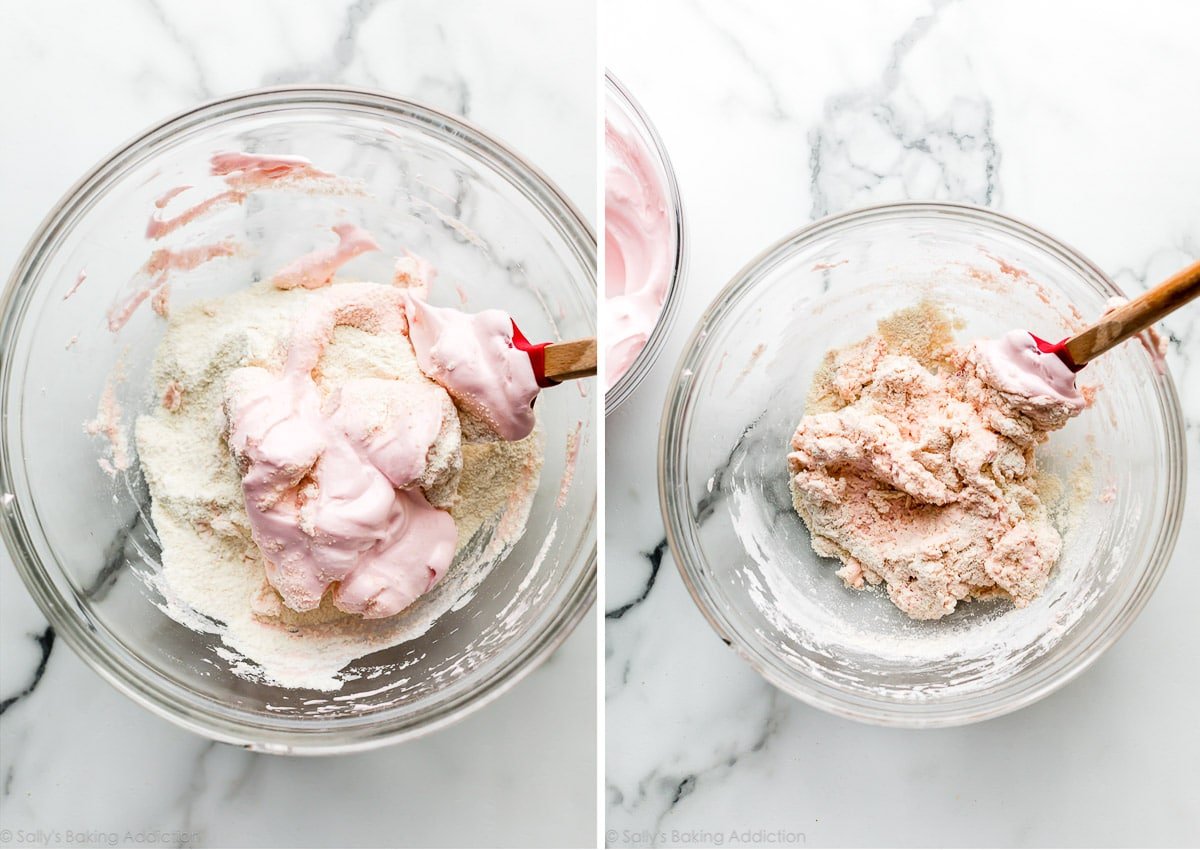
After only 1 addition, the batter will be very thick and dry:
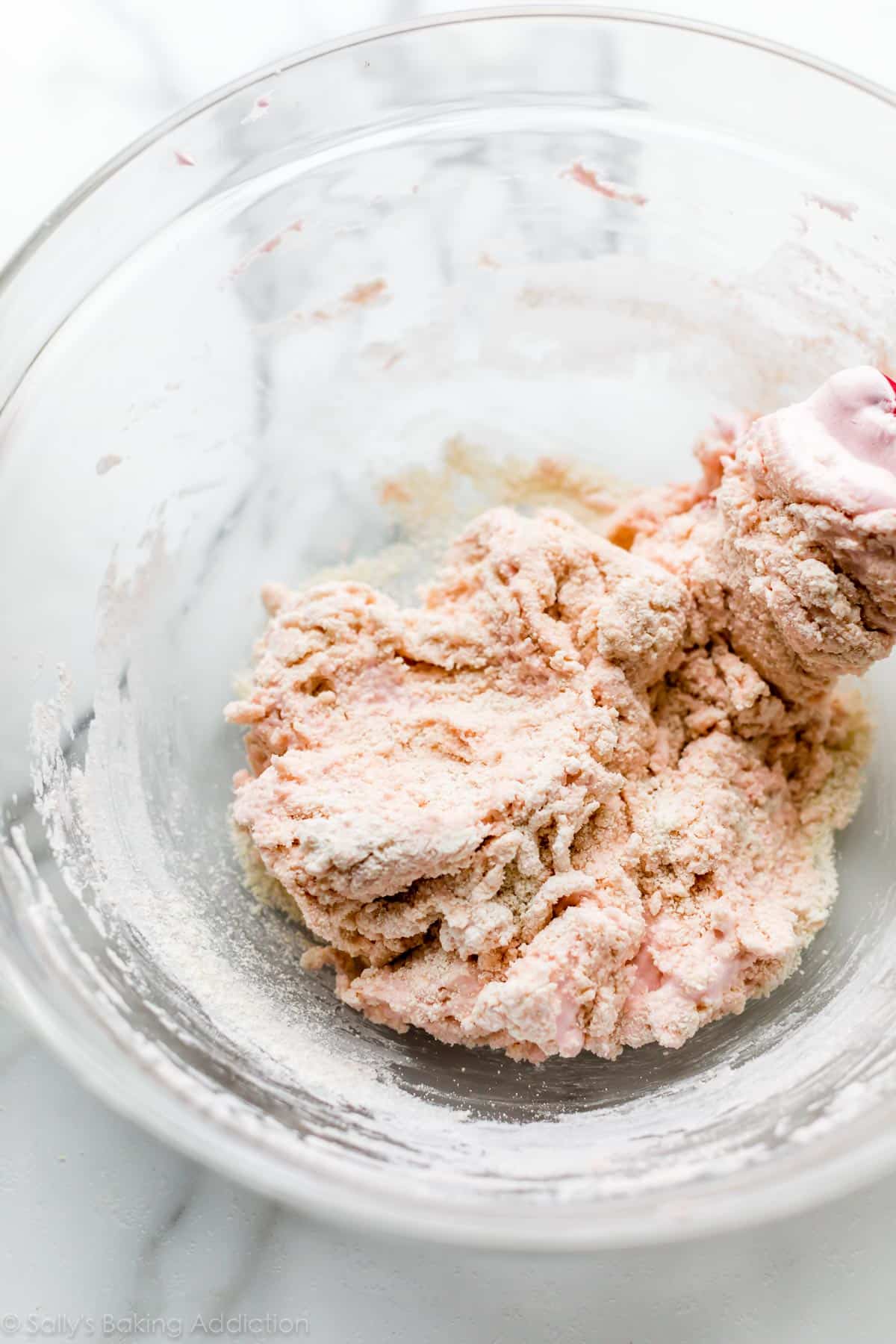
The batter will begin to loosen up after you add the 2nd and 3rd addition:
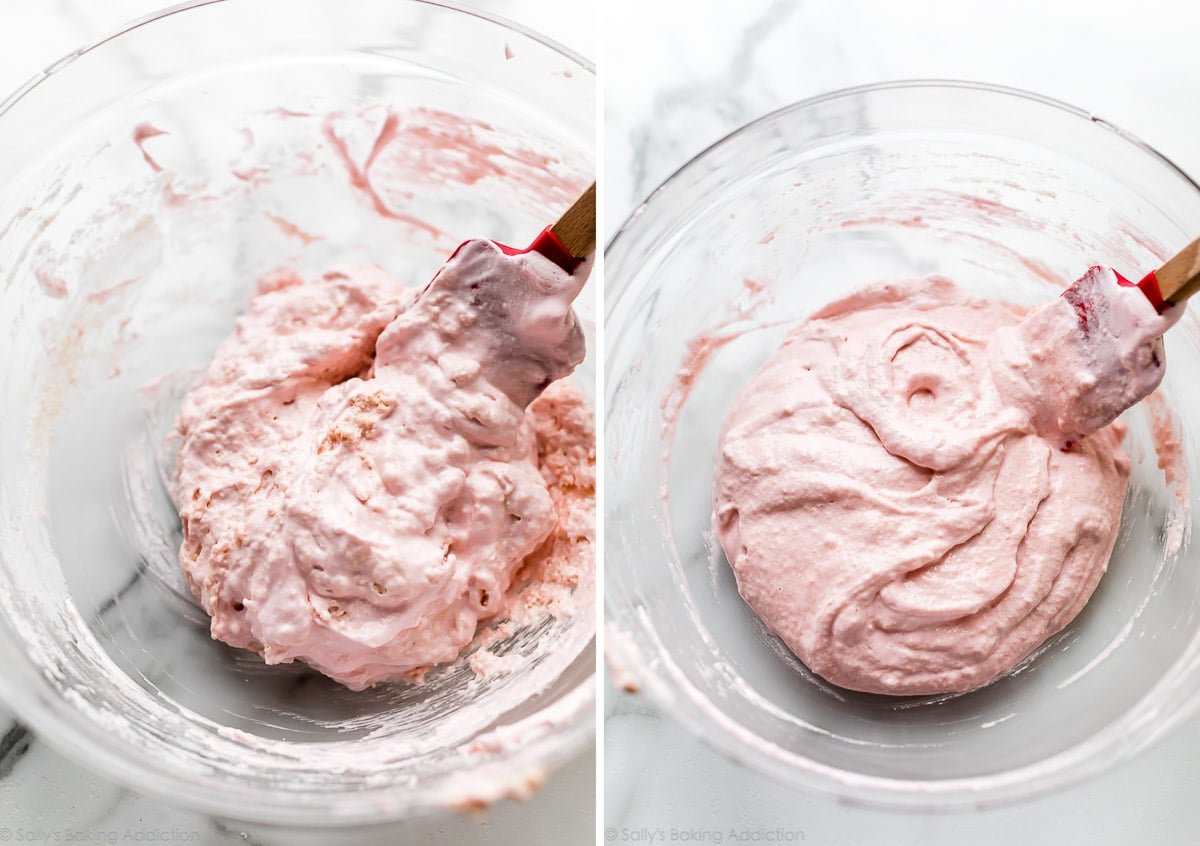
After that 3rd addition of egg whites, you’re at the macaronage stage. You need to keep folding and deflating air until you reach the perfect consistency.
What is Macaronage?
Macaronage is the process of working macaron batter into a shiny and flowy consistency that easily pipes into smooth macaron shells. You may have heard this term before and rightfully so—it’s a crucial step in this macaron recipe. During this stage, you want to be sure not to overmix or undermix the batter. Undermixed and thick batter can produce lumpy or hollow macarons. Overmixed and thin batter can produce cracked macarons or macarons without feet.
Balanced macaron batter after achieving that perfect macaronage is best understood through visuals. Use my video above as a guide starting at the 3:10 minute mark. The photo below should be helpful as well. Drop the macaron batter off of your spatula in the form of a figure 8. The batter will stream off of your spatula like honey and the figure 8 should take no more than 10 seconds to sink back into itself. If it takes less, your batter was overmixed and is too thin. If it takes longer, continue slowly folding the batter to deflate more air.
It’s best to go very slow so you don’t accidentally overmix.
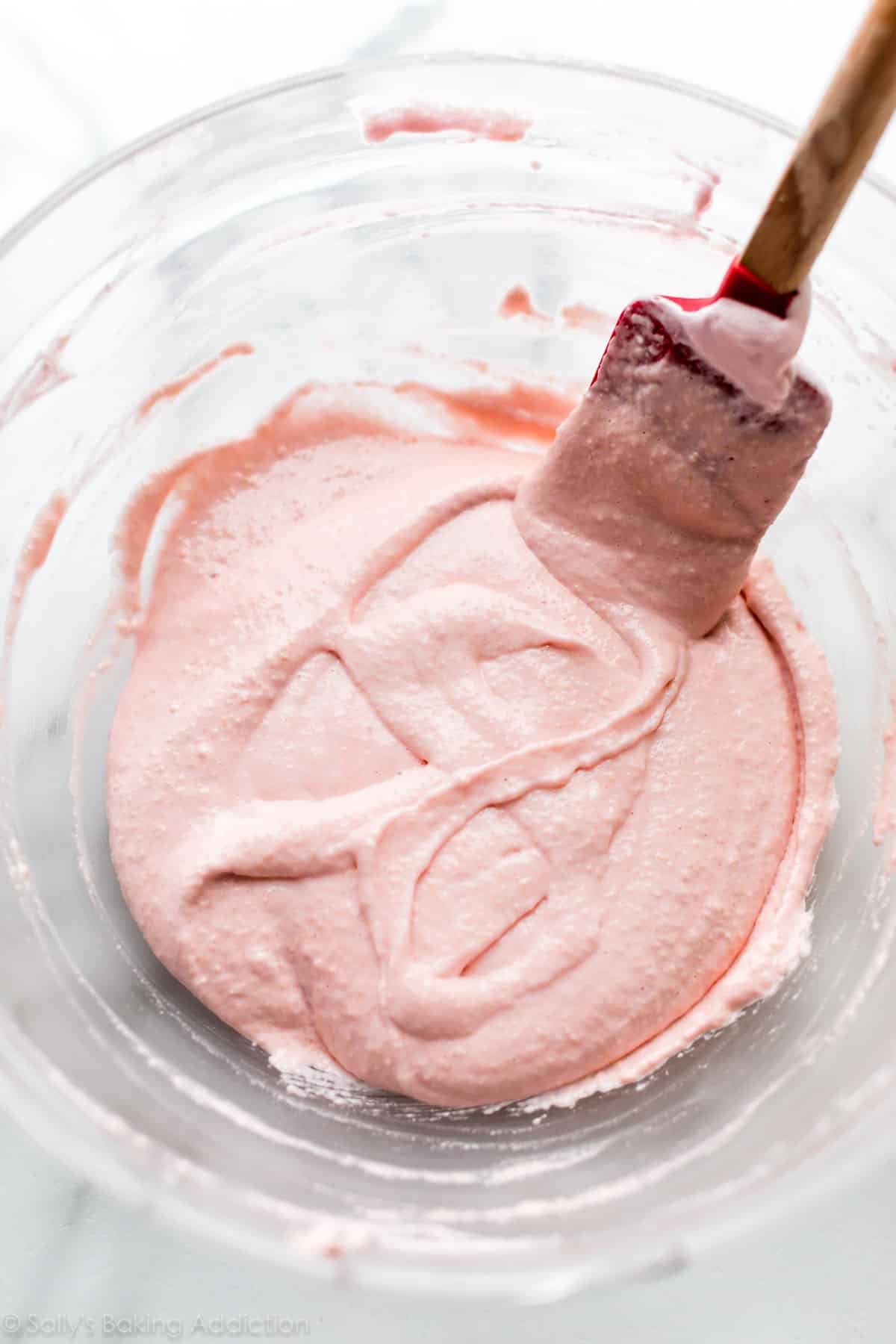
Spoon the macaron batter into your piping bag fitted with your piping tip.
How to Fill a Piping Bag with Macaron Batter
It can be pretty difficult to fill a piping bag with macaron batter since the batter is so drippy. My trick is to use a big cup and you can watch me do this in the video above. Fit the piping bag with a piping tip, then place it in a large cup, folding the top of the piping bag around the rim of the cup. Spoon batter inside, then lift the piping bag out of the cup and twist the end to seal in the batter.
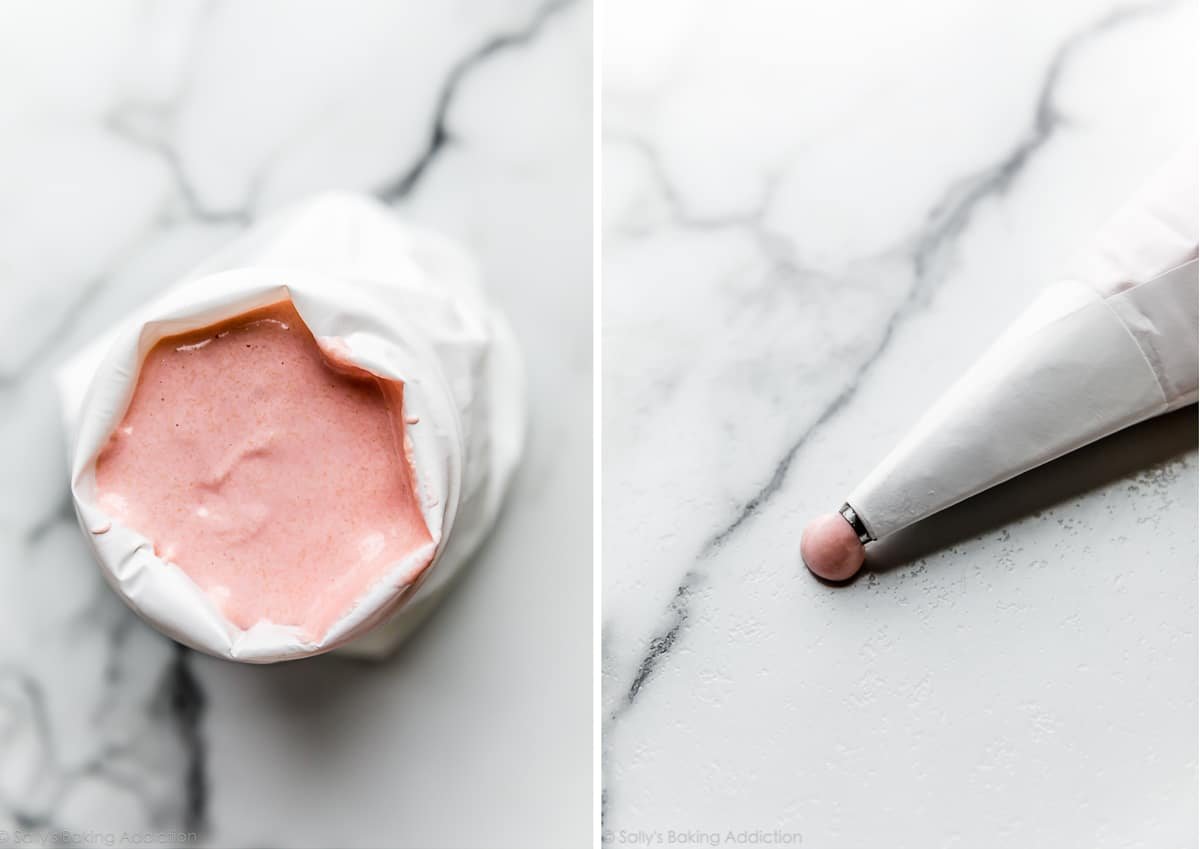
Pipe the batter in 1.5 inch or 2 inch circles at a 90 degree angle on the lined baking sheet. To guarantee your macarons are all the same size (helpful for sandwiching), it helps to have a template or drawn circles on your parchment. You can find free templates online—do a quick “macaron template” internet search—or purchase a macaron-specific silicone baking mat. I usually just trace something about 1.5 inches in diameter (like a medicine bottle cap or small round cookie cutter) with a pen on parchment paper then flip the parchment over. You can see the traced circle through the parchment, which makes an easy template for uniform circles.
Or just eyeball it! I promise no one will be offended by uneven macaron circles.
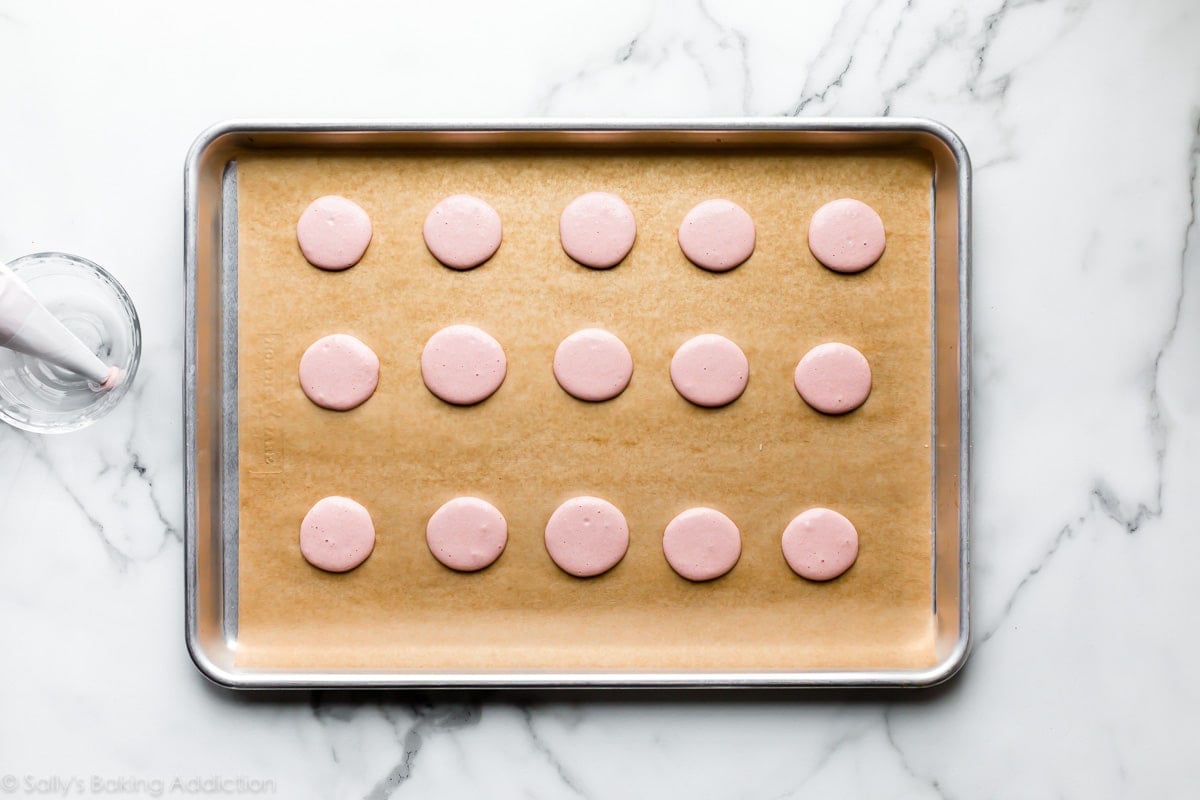
Bang your pan on the counter a couple times to pop any air bubbles. (You can see plenty of air bubbles before I popped them in the photo above.) Use a toothpick to pop any smaller air bubbles. Why is this necessary? Air bubbles will create cracks in your macaron shells. Pop any that you see.
Dry The Shells
There’s one more crucial step before you bake the shells. Let the piped circles sit out until they are dry and no longer tacky on top, usually 30-60 minutes. This time allows the top to firm up and form a skin, which helps the macarons rise UP and form their trademark ruffly “feet.” Your macarons will over-spread and will not have their signature feet if you skip this step.
Do not let them sit out for longer than they need to because they could begin to deflate.
It’s hard to tell in the photo, but these circles are no longer tacky on top and are ready to bake:
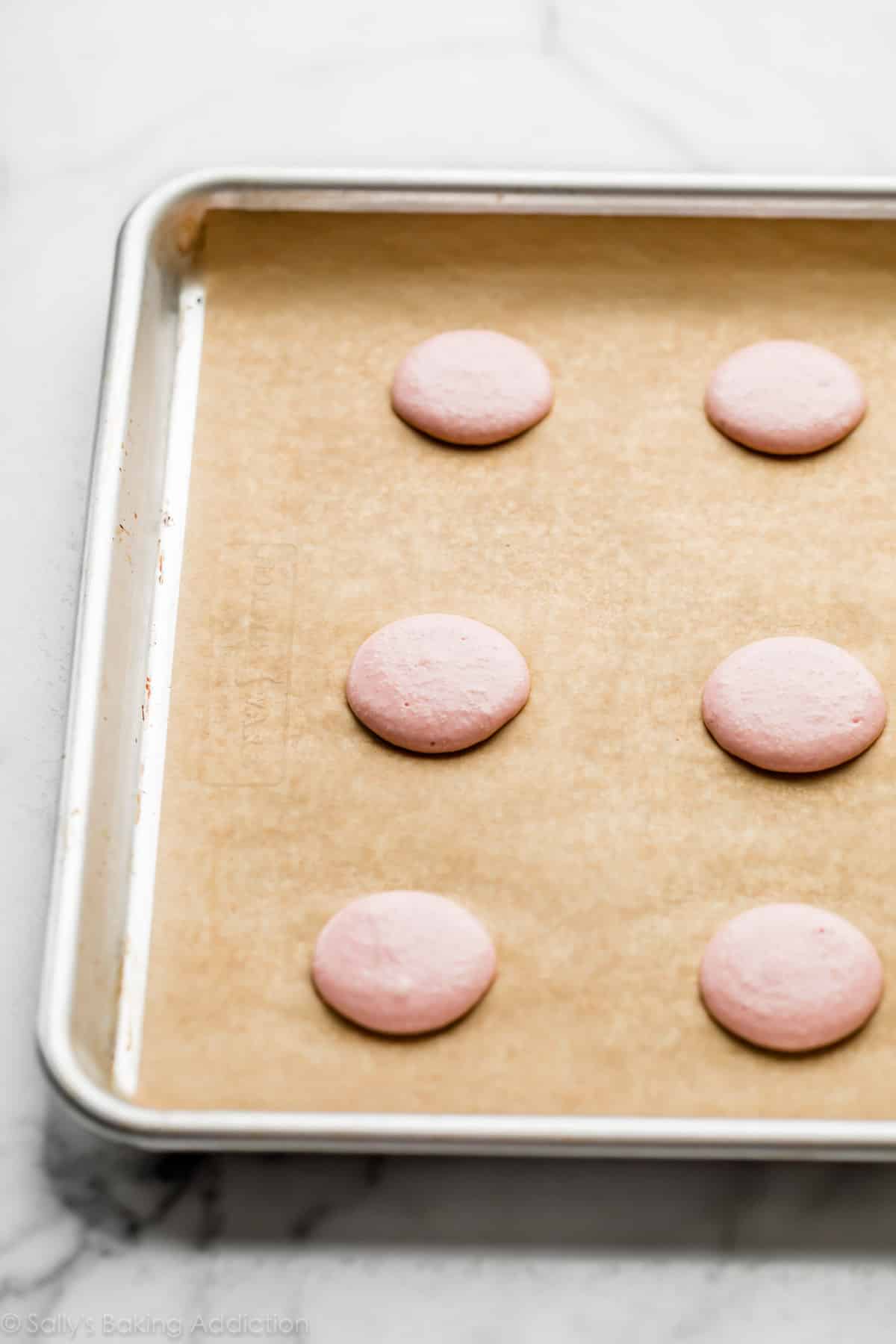
Bake at 325°F (163°C) for 13 minutes. All ovens are different and the actual temperature inside your oven may not match what the display reads. I highly recommend an oven thermometer.
Macarons Are Done Baking When…
As the macaron shells bake, they should form feet. To test for doneness, lightly touch the top of a macaron with a spoon or your finger (careful, it’s hot). If the macaron seems wobbly, it’s not done and needs another 1-2 minutes. If it seems set, it’s done. Basically, bake until the macarons don’t move around when touched.
Let the shells cool on the baking sheet for 15 minutes, then transfer to a cooling rack to continue cooling. The macaron shells may stick to the parchment paper/baking sheet if you try to remove them too early. If this is happening, let them cool on the baking sheet a little longer before removing.
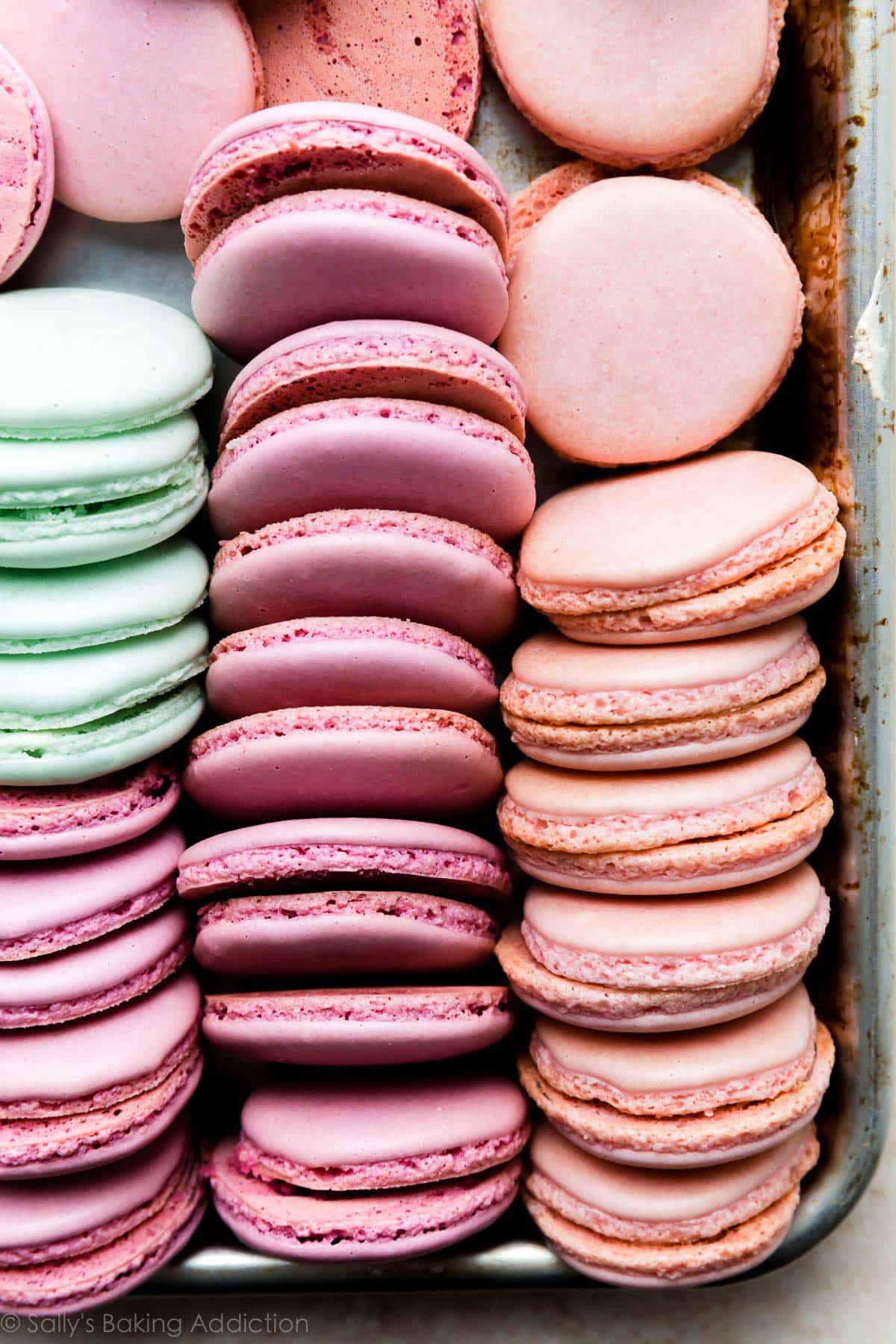
After cooling, the shells are ready to fill and sandwich together. I have plenty of filling suggestions in the recipe notes below. I usually halve my recipe for vanilla buttercream. You can spread the frosting on the underside of half of your macarons with a knife or you can use a piping bag/tip. Just use the same round tip you used for the macaron batter.
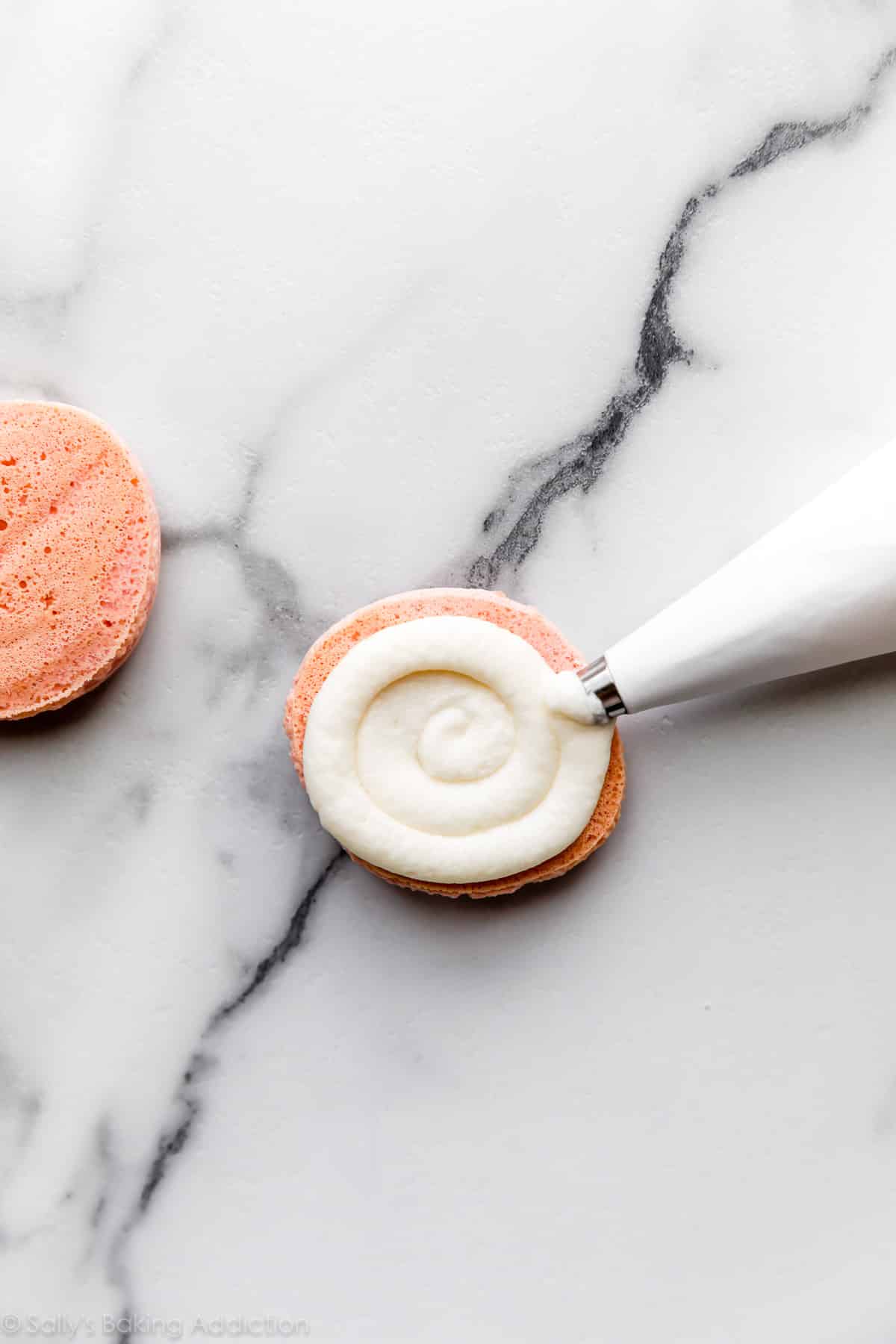
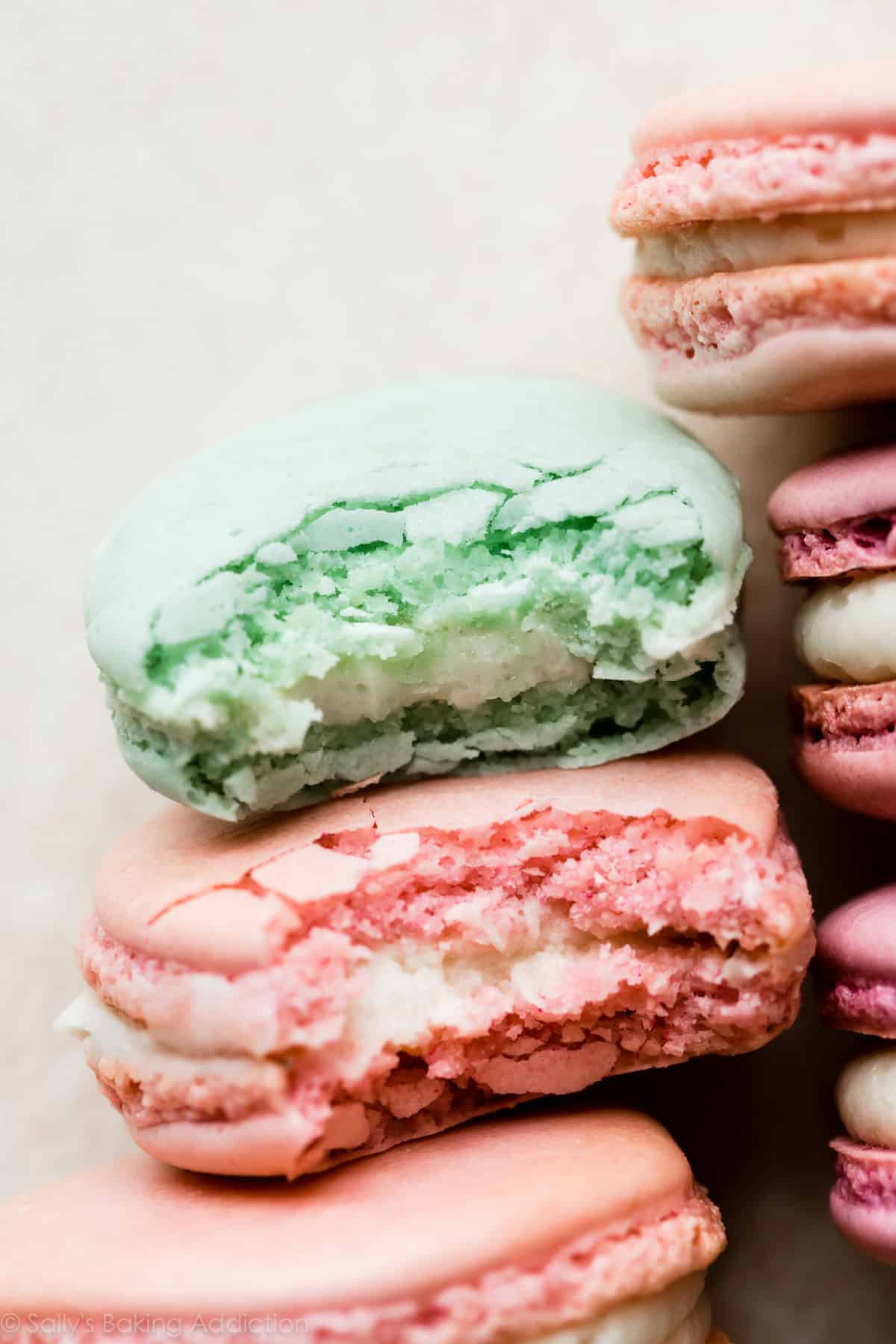
Troubleshooting French Macarons
- Hollow Macarons: It’s always so frustrating to bite into a macaron only to have it filled with… empty air. There are a few culprits leading to this disappointing outcome. If your macarons are hollow, the batter was likely undermixed or overmixed. Pay attention to the proper macaronage. Additionally, make sure you pop and air bubbles in the piped macaron batter as directed in the recipe. And finally, play around with your oven settings. The oven could be too hot or the macarons could be under-baked. All ovens are different and what some bakers find helpful is lowering the oven temperature down to 315°F (157°C) or 300°F (149°C) and extending the bake time by a few minutes.
- Macarons Have No Feet: Avoid over-beating the egg whites and over-mixing the macaron batter. Make sure you let your piped macaron batter dry/sit out before baking. It should no longer be tacky. See “Dry the Shells” above.
- Cracked on Top: If your macarons are cracked on top, they may have been over-baked, the batter may have been overmixed, air bubbles in the piped batter may not have been popped, and/or the egg whites may have been over-beaten.
- Runny Batter: Your macaron batter will be runny if you overmixed it, deflating more air than intended. Macarons baked with runny batter will over-spread, aren’t likely to develop feet, nor will they have the intended chewy texture. This is why the macaronage step is crucial. Fold the batter together slowly and perform the figure 8 test a few times until you have the correct consistency.
- Imperfect Piped Circles: Don’t get upset over this! My macaron batter is NEVER piped into perfect circles. You can even see in these photos that some are larger than others. Using a template helps, but so does practice.
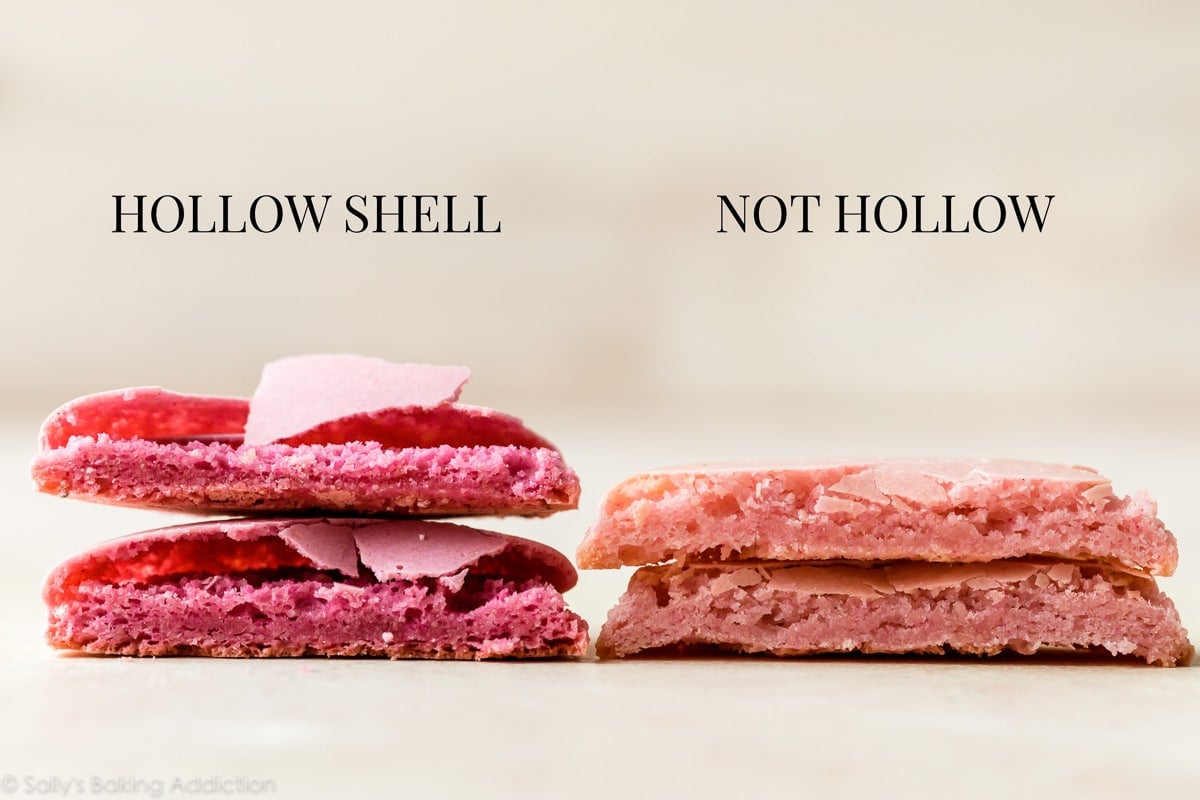
5 Final Success Tips:
- Wipe down your egg white bowl and beaters/whisk attachment with vinegar or lemon juice to rid any grease or fat residue.
- Use large metal or glass mixing bowls.
- Bake macarons on a dry day. If it’s particularly humid, the piped batter will take awhile to dry and the shells may not develop feet.
- Pay attention to proper macaronage, explained and shown above.
- Do not make any ingredient substitutions or deviate from the instructions.
So, Are These Worth the Effort?
Yes. But, of course, we all have different taste buds and levels of patience. Once you understand the process, they’re perfectly doable. And it’s a lot of fun to play around with different fillings. Have fun and don’t stress out. Even the ugly ones can be delicious. Just load them up with a filling and no one will care! 😉
Further Reading and Fun Flavors:
- Cookies and Cream Macarons and Pistachio Macarons from House of Nash Eats
- Lemon Macarons from Indulge with Mimi
- Ultimate French Macaron Guide by Mike Bakes NYC (so helpful!)
- Chocolate Hazelnut Macarons by Sweet & Savory by Shinee
- Macaron Troubleshooting by Sweet & Savory by Shinee (incredibly comprehensive and helpful)
- The Art of Macaron Making on Bob’s Red Mill
- Sprinkle Macarons by Cloudy Kitchen
- Chocolate Macarons by Sugar Geek Show
- French Macarons Recipe Guide on Bigger Bolder Baking (includes a template)
See Your French Macarons!
Many readers tried this recipe as part of a baking challenge! Feel free to email or share your recipe photos with us on social media. 🙂
Print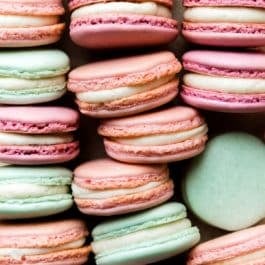
French Macarons
- Prep Time: 1 hour (plus aging egg whites)
- Cook Time: 13 minutes
- Total Time: 1 hour, 30 minutes
- Yield: about 40 shells; 20 sandwiched macarons
- Category: Dessert
- Method: Baking
- Cuisine: French
Description
Review this page, video, troubleshooting, and success tips and follow the recipe precisely for crisp, chewy, delicate French macaron cookies. Have fun with fillings! I provide some filling ideas in the recipe notes. We strongly recommend using gram measurements, but see recipe note if you do not have a kitchen scale.
Ingredients
- 100g egg whites (usually between 3–4 large egg whites)
- 1/4 teaspoon (1g) cream of tartar
- 1/2 teaspoon extract such as vanilla, almond, coconut, etc. (optional)
- 80g superfine sugar (aka caster sugar, see note)
- 1–2 drops gel food coloring (optional)
- 125g almond flour
- 125g confectioners’ sugar
- desired macaron filling (some options listed in notes)
Instructions
- Wipe down a large glass or metal mixing bowl with lemon juice or vinegar. Add egg whites. Cover and refrigerate for 24 hours, then bring to room temperature.
- Line 3 large baking sheets with silicone baking mats or parchment paper. Set aside.
- Add cream of tartar and extract (if using) to egg whites. Using a handheld mixer or stand mixer fitted with a whisk attachment, beat together on medium speed until very soft peaks form. This takes a few minutes of beating. At first the egg white and cream of tartar mixture will be foamy, then the bubbles will begin to tighten and the beaters will leave tracks as the egg whites build volume. Once they begin leaving tracks, you likely have soft peaks. Stop beating. Add about 1/3 of the superfine sugar. Beat on medium-high speed for 5 seconds, then with the mixer continuing to run, add another 1/3 of the sugar. Beat for 5 seconds, then with the mixer continuing to run, add the remaining sugar. Beat on medium-high speed until stiff glossy peaks form. (This means the whites have stiff, smooth, and sharp points in the bowl or on the lifted whisk attachment/beaters. Stiff peaks do not droop down. You can turn the bowl upside down and the egg whites will not move or spill out.) Using a rubber spatula, slowly and gently fold the food coloring (if using) into the egg whites.
- Sift the almond flour and confectioners’ sugar together in a large glass or metal mixing bowl. Use a spoon to help work any larger pieces through the sieve. You don’t want to discard a lot of that because then you won’t have enough dry ingredients in the batter.
- Slowly fold the beaten egg whites into the almond flour mixture in 3 separate additions, folding until combined before adding the next addition. After you add all of the egg whites, pay very close attention to the consistency of your macaron batter. Continue folding the batter (which deflates air) until it thins out into the consistency of honey. What’s a more helpful cue is the figure 8 test. Drop the macaron batter off of your spatula in the form of a figure 8. The figure 8 should take no more than 10 seconds to sink back into itself. If it takes less, your batter was overmixed and is too thin. If it takes longer, continue slowly folding the batter to deflate more air, then perform the figure 8 test again. It’s best to go very slow so you don’t accidentally overmix.
- Spoon the macaron batter into a piping bag fitted with a medium round piping tip, such as Wilton 12, Wilton 1A, or even Ateco 806. The macaron batter is very drippy, so transferring to the piping bag can be messy.
- Holding the piping bag at a 90 degree angle over the baking sheet, pipe batter in 1.5 – 2 inch rounds about 1-2 inches apart on prepared baking sheets. I usually pipe little mounds—see video tutorial above. The piped macaron batter flattens out. Bang the pan a couple times on the counter to pop any air bubbles, then use a toothpick to pop any remaining air bubbles.
- Let the piped macarons sit out until they are dry and no longer tacky on top, usually 30-60 minutes. This time allows the top to firm up and form a skin, which helps the macarons rise UP and form their trademark ruffly “feet.” Do not let them sit out for longer than they need to because they could begin to deflate.
- Meanwhile, preheat the oven to 325°F (163°C).
- Bake for 13 minutes. As the macaron shells bake, they should form feet. To test for doneness, lightly touch the top of a macaron with a spoon or your finger (careful, it’s hot). If the macaron seems wobbly, it’s not done and needs another 1-2 minutes. If it seems set, it’s done. Basically, bake until the macarons don’t move around when touched.
- Let the shells cool on the baking sheet for 15 minutes, then transfer to a cooling rack to continue cooling. The macaron shells may stick to the parchment paper/baking sheet if you try to remove them too early. If this is happening, let them cool on the baking sheet a little longer before removing.
- After cooling, the shells are ready to fill and sandwich together. I have plenty of filling suggestions in the recipe notes below. You can spread filling with a knife or pipe it using the same round tip you used for the macaron batter.
- You can eat right away or, as some professionals prefer, cover and refrigerate them 12-24 hours so the macarons and flavors can mature. Bring to room temperature before serving. (I usually just serve them right away!)
- Cover leftover macarons and refrigerate for up to 5 days.
Notes
- Freezing Instructions: Cooled macaron shells and finished assembled macarons can be frozen for up to 1 month. Thaw at room temperature before filling/serving.
- Special Tools (affiliate links): Electric Mixer (Handheld or Stand) | Glass Mixing Bowls or Metal Mixing Bowls | Egg Separator | Food Scale | Fine Mesh Sieve | Piping Bag (Disposable or Reusable) | Medium-Round Piping Tip (Wilton 12, Wilton 1A, or Ateco 806) | Baking Sheets | Silicone Baking Mat, Macaron-Specific Silicone Baking Mat, or Parchment Paper | Cooling Rack
- Ingredient Substitutions & Weights: I do not recommend any ingredient substitutions in this recipe. Using weights (and a food scale) is the best way to guarantee success. However if you do not own one, use the following approximate measurements: for the superfine sugar, use 1/3 cup. For the almond flour and confectioners’ sugar, you need about 1 cup + 1 teaspoon each.
- Egg Whites: For best and most consistent results, I strongly recommend using fresh egg whites instead of liquid egg whites from a carton.
- Extract/Flavoring: I keep these macarons plain. Without flavoring, they have a sweet almond flavor. However, if desired, feel free to add 1/2 teaspoon of your favorite extract such as almond, vanilla, coconut, lemon, etc.
- Make Your Own Superfine Sugar: Add 80g of regular granulated sugar to your food processor or blender. Pulse about 10-15x until granules are much finer, aka superfine sugar. Weigh 80g superfine sugar—should be about the same amount you started with.
- Optional Food Coloring: Tinting macaron batter is completely optional. If you don’t tint it, the macarons will be a natural beige color. Avoid using liquid food coloring because it will change the consistency of your macaron batter. Instead, use 1-2 drops of gel food coloring. (I used dusty rose, aqua, and fuchsia.) Powder food coloring should be fine, but I haven’t tested it. Only use a very small amount.
- Almond Flour: Make sure you use almond flour, not almond meal. It is usually labeled as “fine” almond flour. Almond flour is much finer than almond meal and made from blanched, skinless almonds. Almond meal is coarser and contains almond skin. You can make your own almond flour, but be very careful because almonds can quickly release their oils, clump up, and turn into almond butter. It might be easier to just pick up a bag of fine almond flour. It’s very common in mostly all grocery stores these days– I use and love Bob’s Red Mill brand.
- Macaron Filling Ideas: The pictured macarons are filled with vanilla buttercream (I prepared a half batch). Other ideas are a 1/2 batch of chocolate buttercream, lemon buttercream, chocolate peanut butter frosting, Nutella frosting, cream cheese frosting, champagne frosting, strawberry frosting, or a full batch of peanut butter frosting. Cooled and thickened chocolate ganache or cooled salted caramel are great, too!
Adapted from Les Petits Macarons and Mad About Macarons


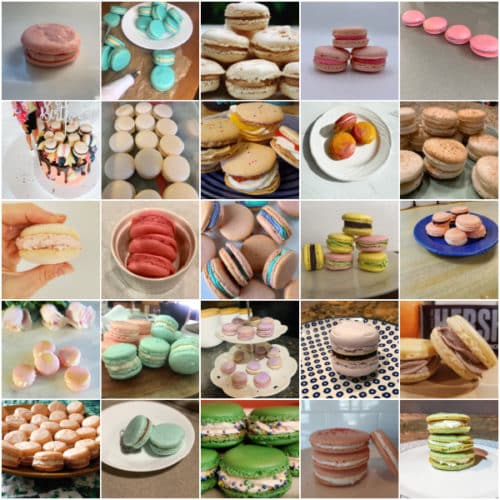
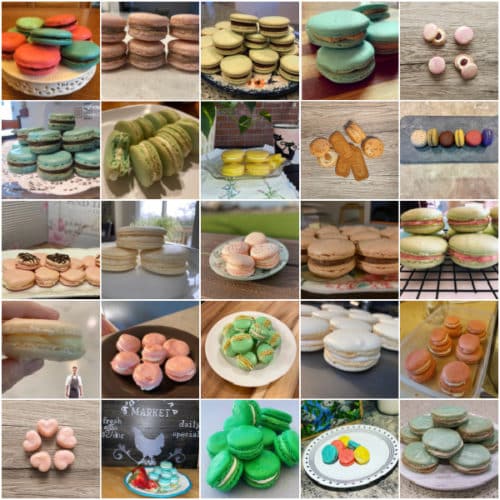
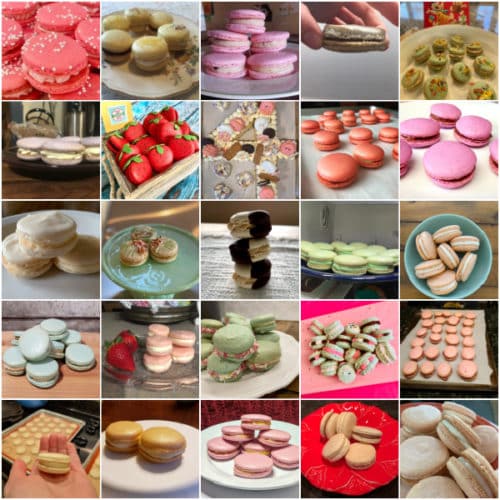
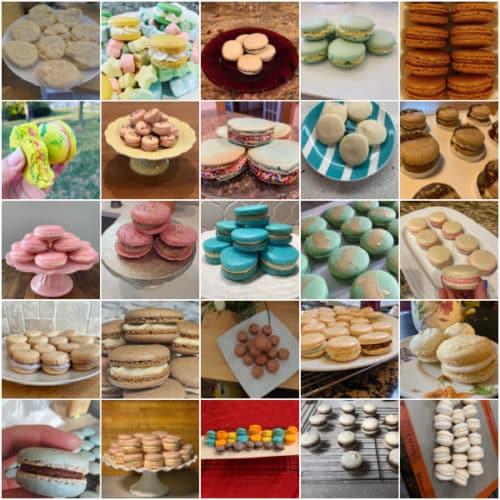
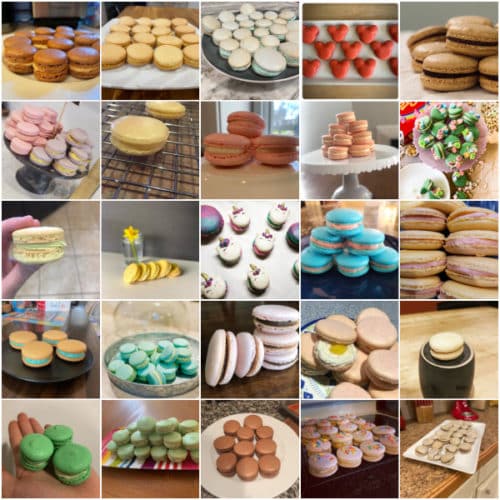
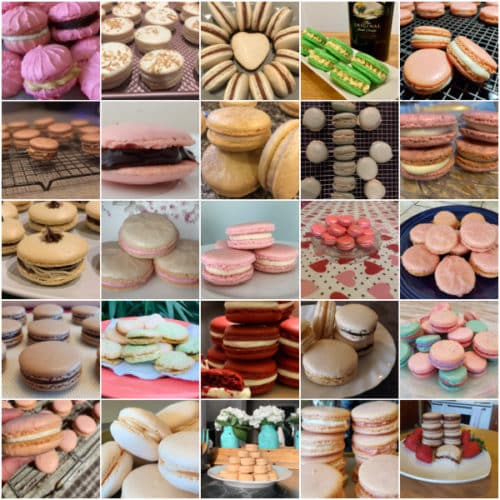

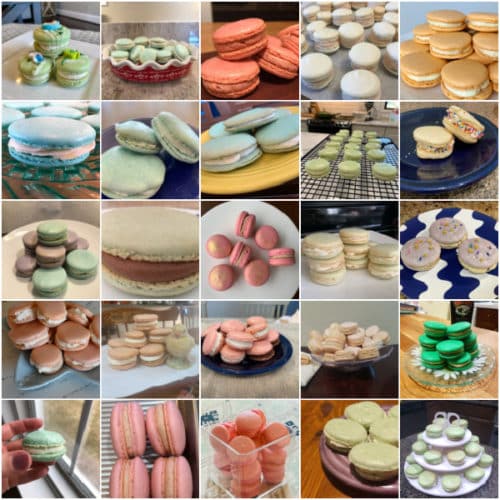
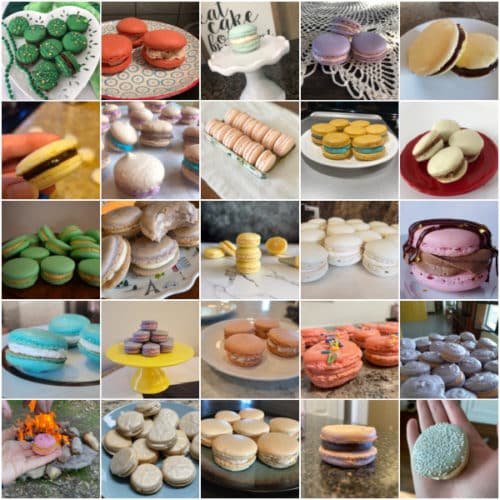
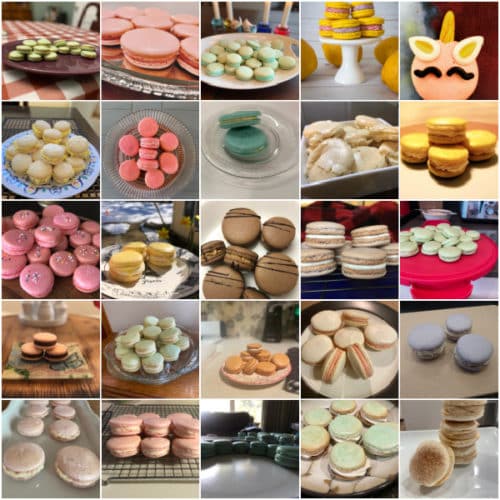
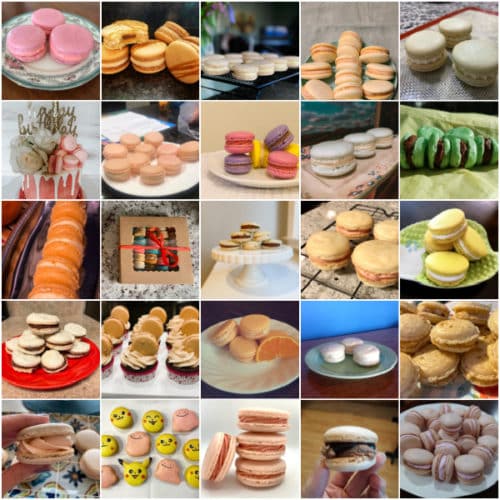
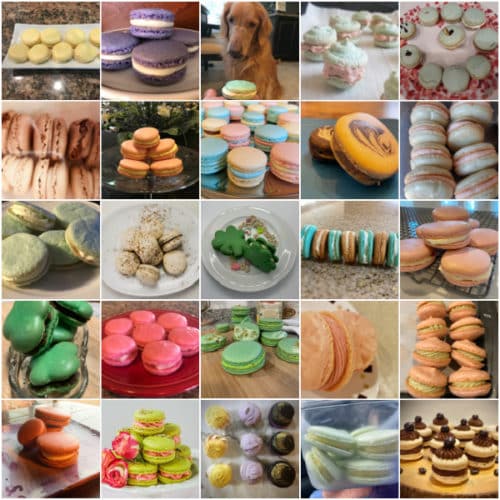
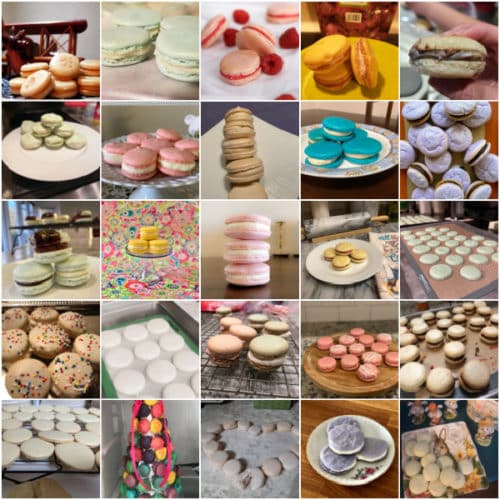
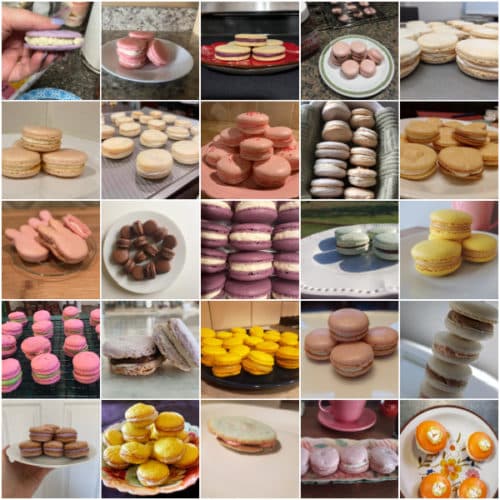
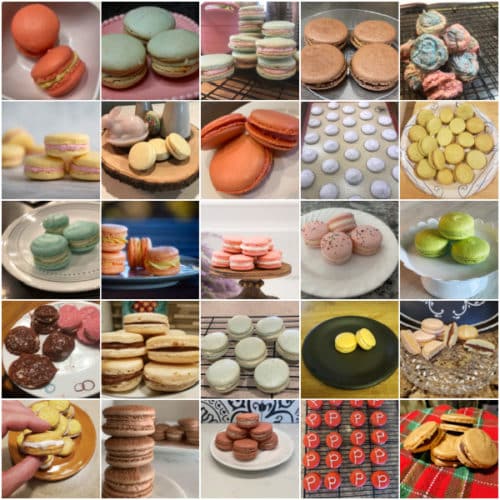
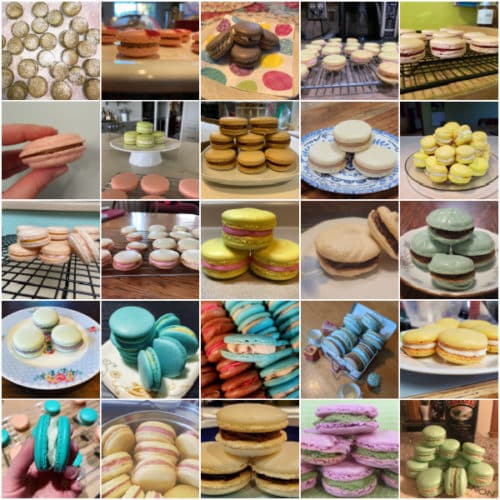
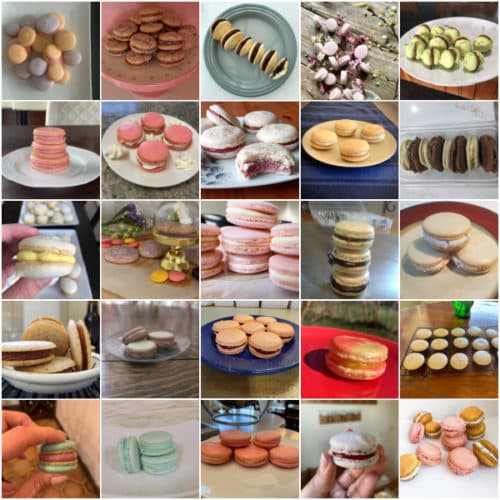
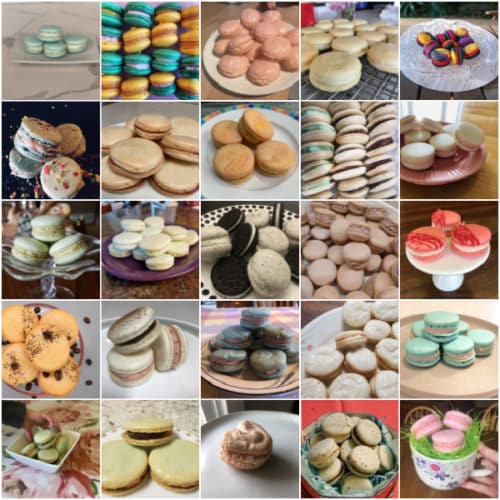
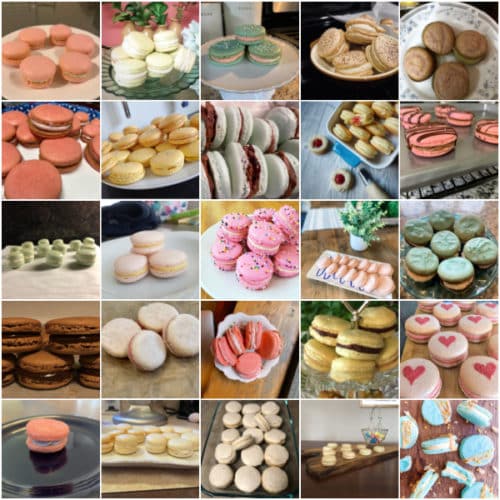
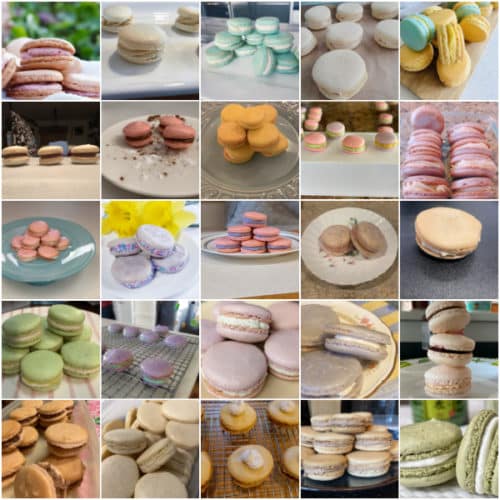

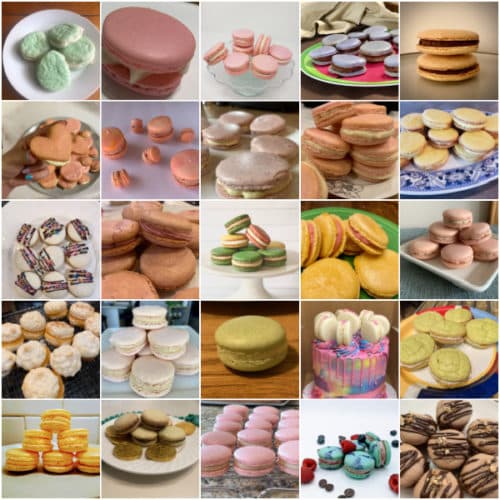
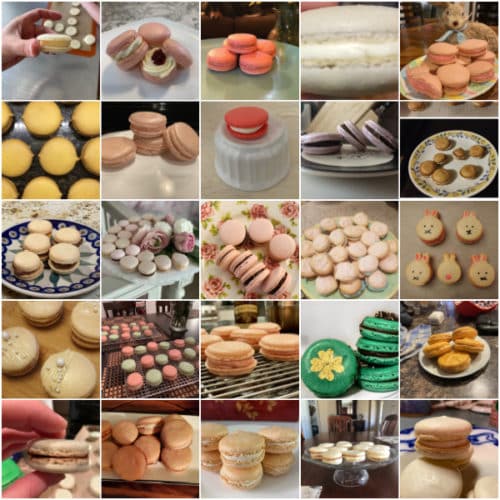
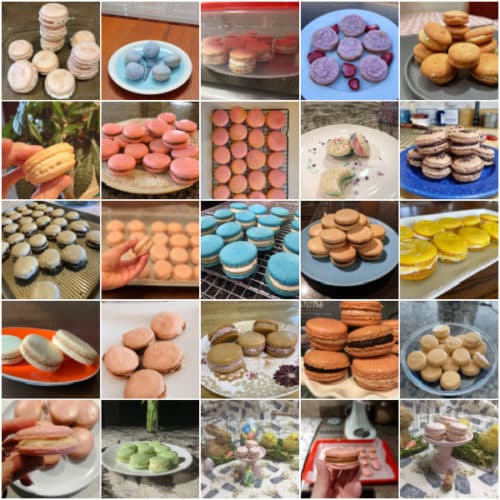
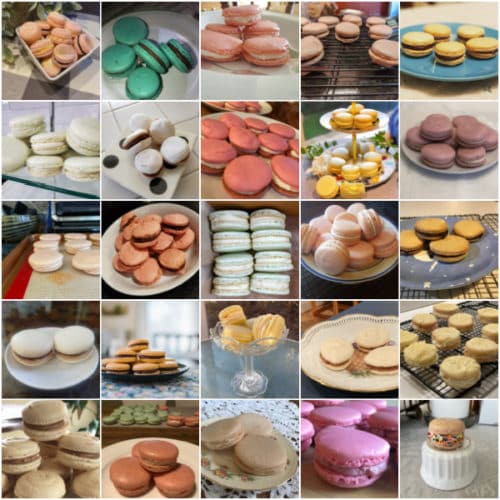
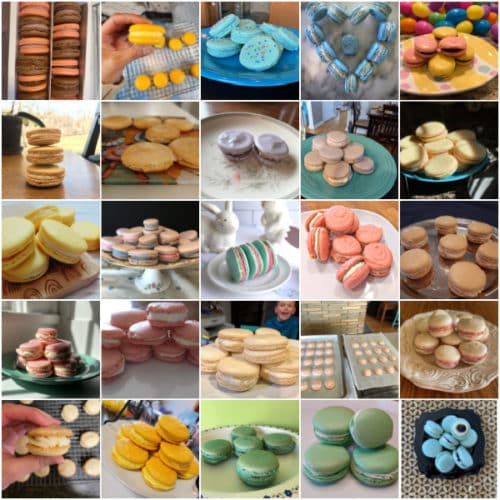
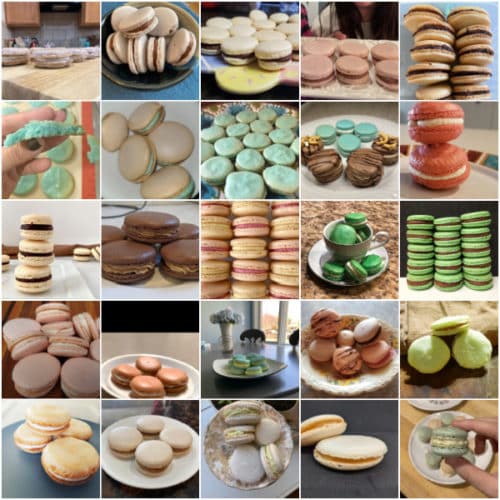
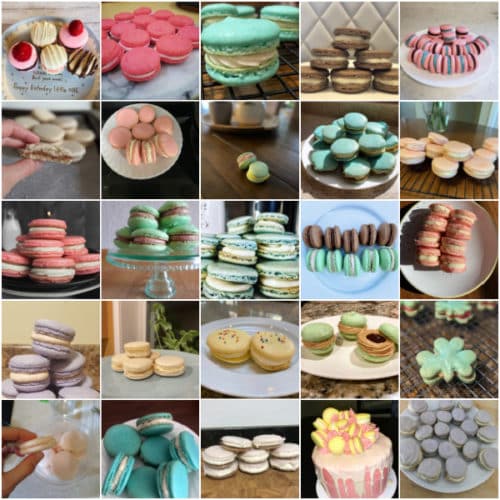
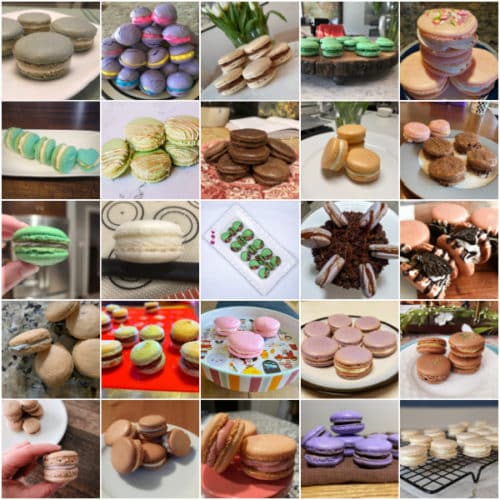
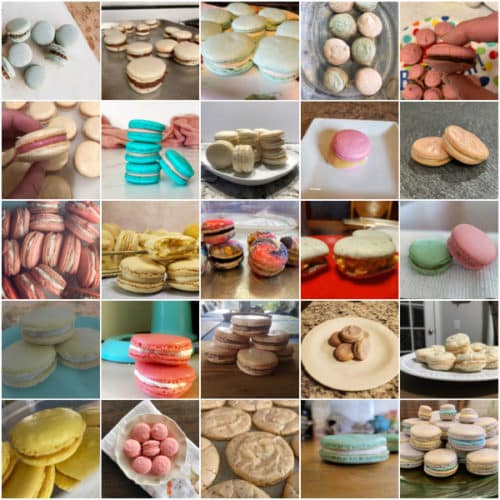
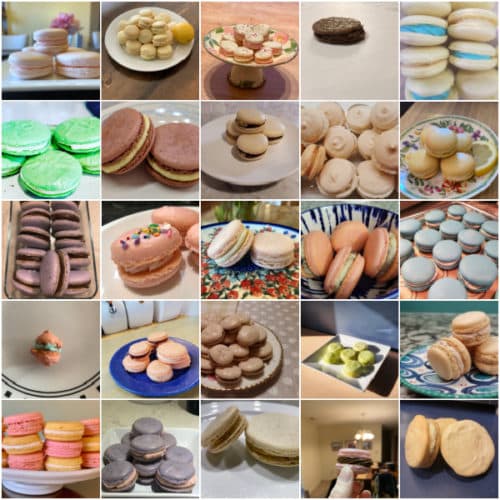
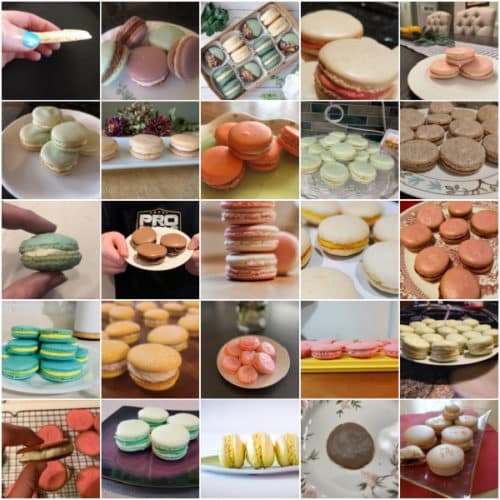
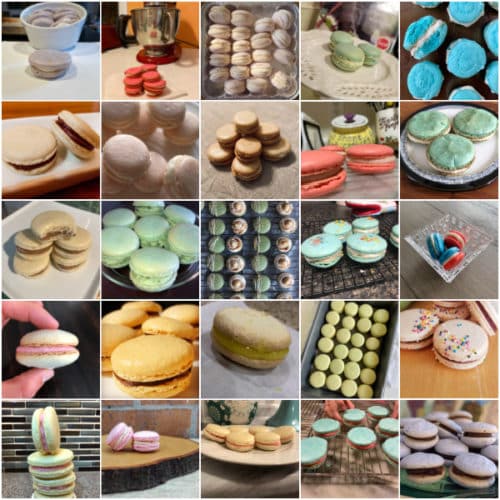
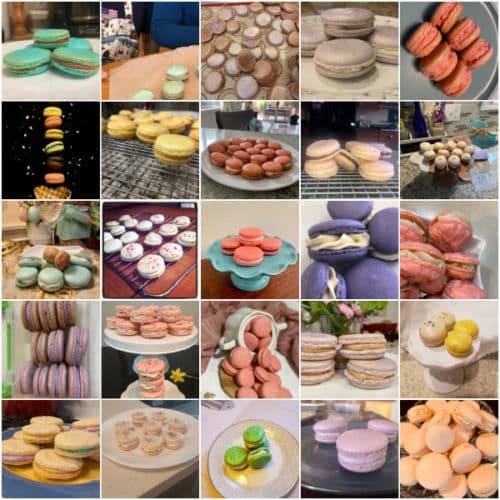
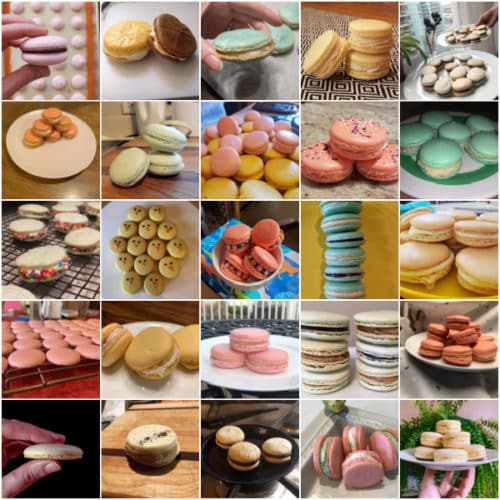
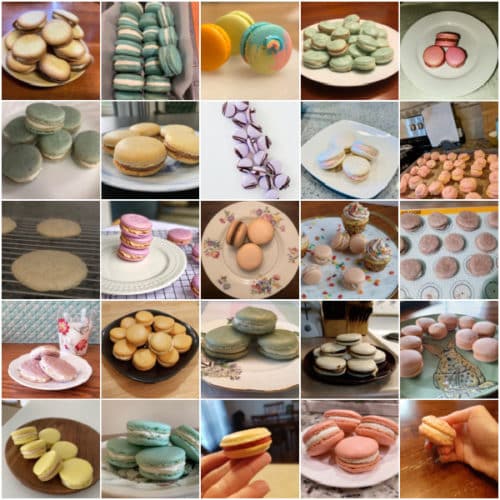
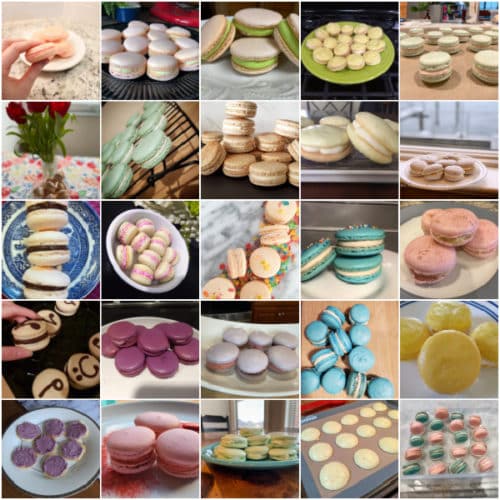
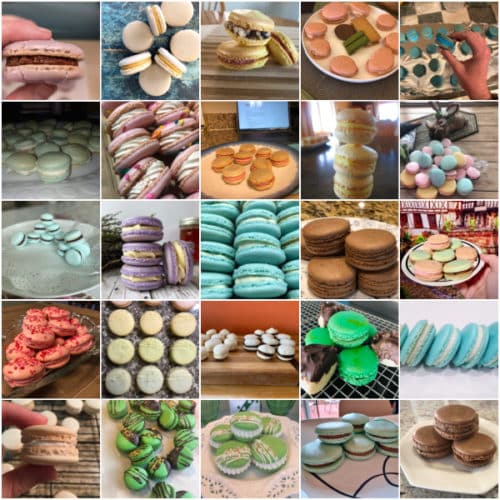
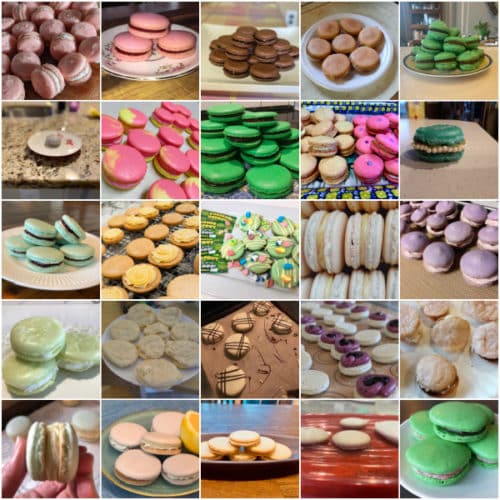
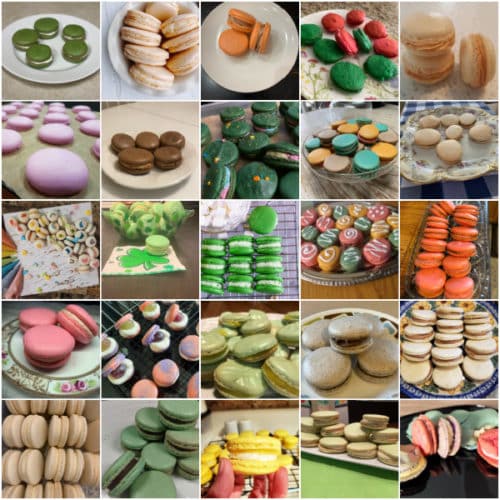
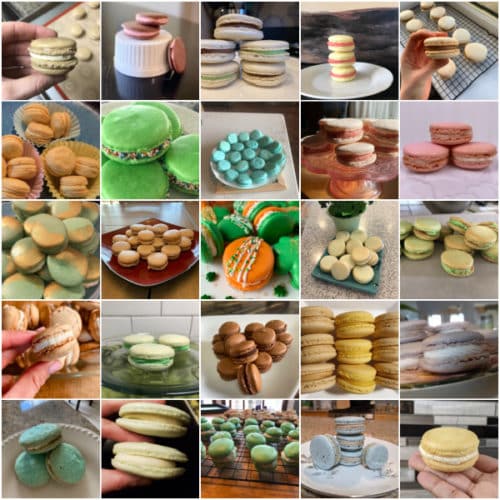
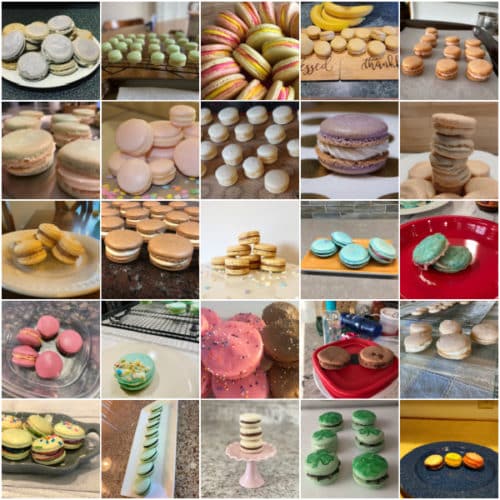

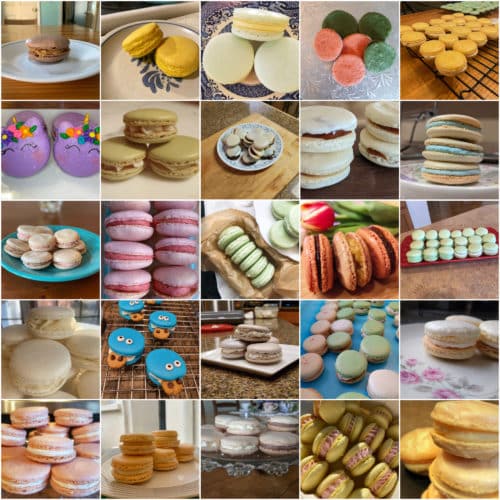
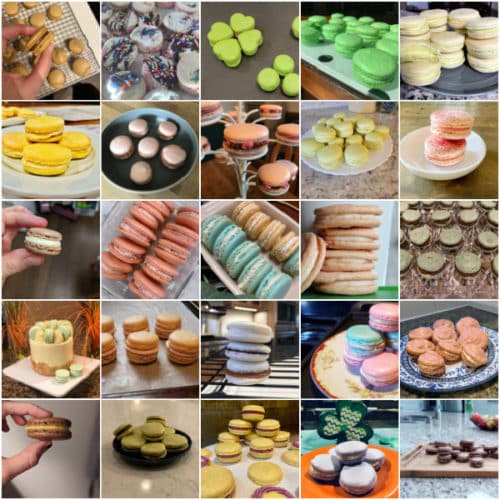
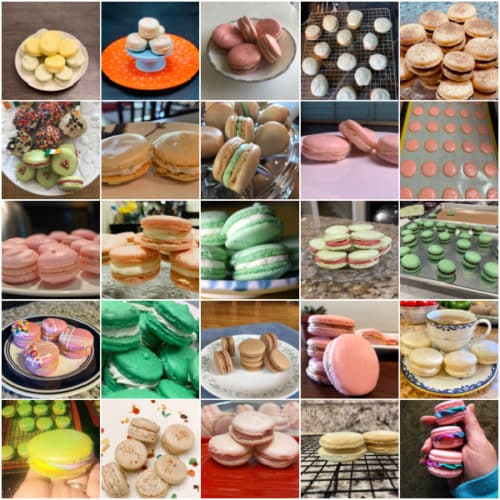
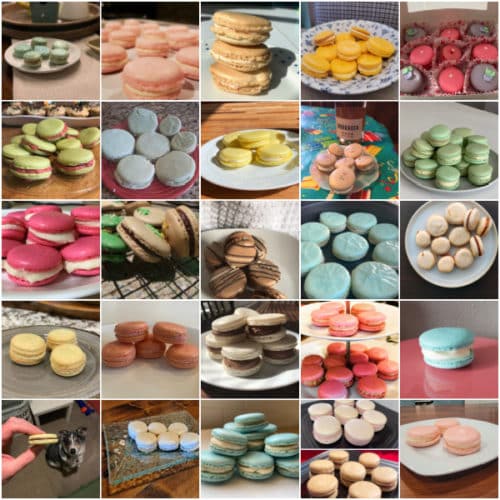
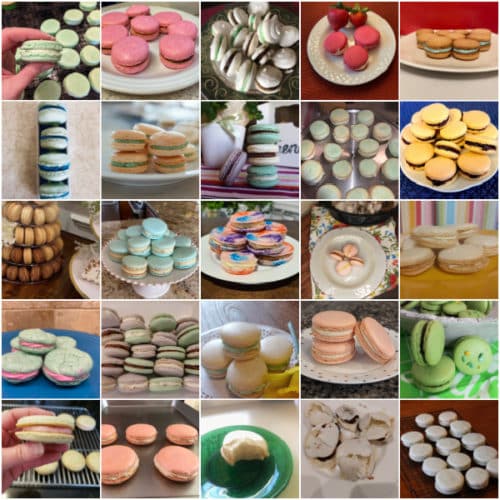

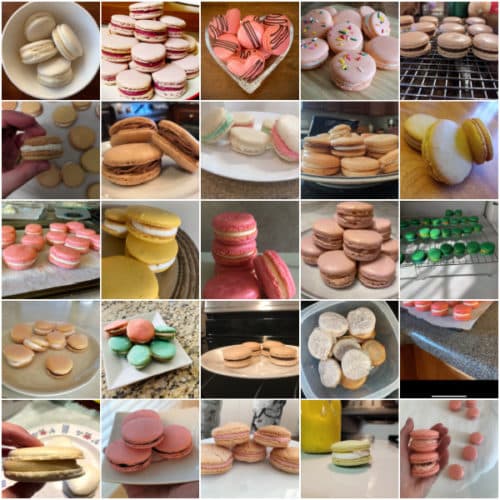
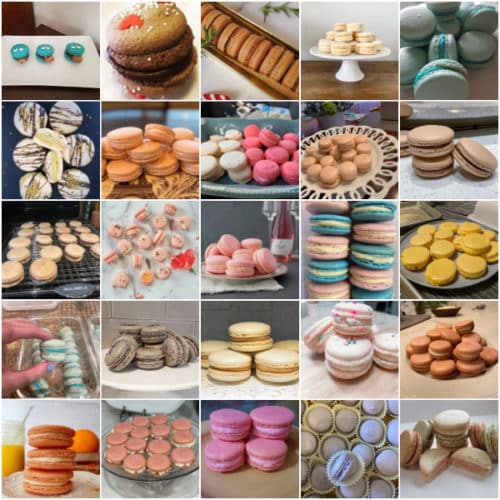
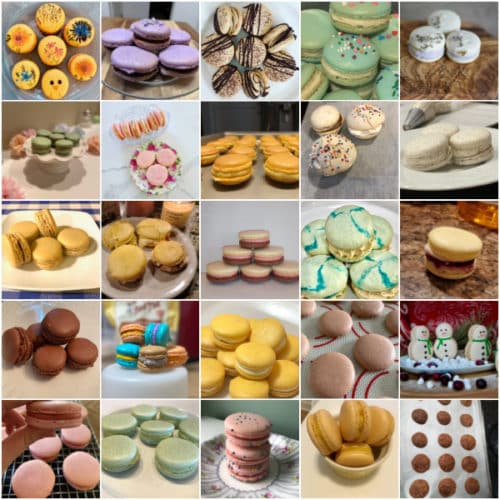



















Hi Sally,
Thank you for sharing the recipe.
One quick question: if I want to add the rose extra to the macaron batter, do I need to adjust the quantity of it?
Hi Allie, we haven’t tried rose extract in these. Depending on how strong you want the flavor, we would add up to 1/2 tsp. Enjoy!
Recipe looks great. Can’t wait to try it. In the meantime, can you tell me the title of the music in the background of your video? Thank you.
This recipe and guide is amazing! We succeeded at making delicious macarons on the first go! Thank you so much for taking the time to put together these detailed instructions, the pictures and video were so helpful.
hi! i was just wondering if the egg whites can be refrigerated for less time than a day?
thank you!
Hi Jesu, For the best results we do recommend letting them age for at least 24 hours.
I made these yesterday, and they turned out great! however, I was wondering if there was a way to lessen the amount of confectioners sugar? what would be the least amount you’d recommend?
Hi K, We are so happy you enjoyed this recipe! It’s very particular and exact, so for the best results we do not recommend straying from the written recipe at all.
I SO wanted to make macarons for all of my neighbors for a holiday present. Researched thoroughly and thought your site gave most careful directions. I am an experienced, meticulous cook. I spent the entire day today making numerous batches, all for naught. They looked gorgeous but were glued to the parchment/silicon mat (tried both). My ingredients were what you recommended by brand, carefully measured w/ my good digital scale. Absolutely no problem with blending the egg whites (stopped as soon as stiff peaks and I could turn the bowl upside down), BUT it was very clear from your video that, when you mixed the whites with your dry ingredients, you had a much wetter batter from the get go. THAT was the clear issue. I tried increasing the whites to 115 grams as you suggested to someone, which helped a little but not near enough. As others have commented, no matter how much I mixed, I could never get the batter to quite the fluidity that you achieved. Piped nicely, dried nicely, baked nicely (not wobbly at 315 for 15 minutes), fine texture, no cracks, but glue, glue, glue. Chewy and gluey are two different things! The only possibility is that 125 g each of almond flour and confectioners sugar was either too much or not the optimal ratio. What would you suggest?
Hi Ava, thank you for trying the recipe. I wonder if baking the shells for another 1-2 minutes would help firm up the bottoms so they weren’t so tacky. It could be as simple as that if you ever want to try it again. If you’d like to fix it before baking, see if reducing the almond flour down to 110g will help. Thank you again for trying the recipe and appreciate the feedback!
I had a dozen egg whites in the freezer after mixing up a batch of egg nog so that was a perfect opportunity to finally tackle macarons. This was my first batch ever and they turned out OK! They were a little low on feet and cracked a bit. I think I deflated the egg whites too much trying to fold in an overly large glob of food coloring, or maybe because I used thawed egg whites. And they are not uniform. BUT they still look pretty and taste good. I don’t know if the texture is right because I have never been willing to fork out the $$$$$ for a macaron!
Hey, I’ve made a handful of batches with this recipe and appreciate all the detail. I had beginner’s luck on my first shot and they turned out great, but in the batches I made yesterday they seemed to consistently overbake (started to brown and crack) on the outside but were underbaked (stick to silpat, still doughy) on the inside. My oven is on the older side, but I have an oven thermometer that generally reads out the correct temp. Any advice? Thanks!
Hi Willie, did you happen to make any changes to the recipe? It sounds like it could be a heating issue with your oven. For next time, you can try moving the macarons away from the heating element a bit in order to prevent the tops from browning too fast, and then adjust the bake time as needed.
I haven’t attempted this recipe yet. What do you mean by “fresh” egg whites instead of from a carton?
Anne
Hi Anne, use egg whites cracked from an egg, not liquid egg whites you can purchase in a jug/carton.
Hi
Is it possible to bake the macrons ahead of time and freeze them?
Hi Kathy, see recipe notes for make ahead/freezing instructions.
I have made this recipe before (loved it!!) with regular aged egg whites per your method and they came out great.
I found myself with a bunch of extra CARTON egg whites left over from another recipe (bought too much). Can I make these with the carton egg whites? I know you guys don’t recommend it, but is there a reason why? I’d rather make something yummy with these than toss them.
Hi Caitlin, We are so happy that you enjoyed this recipe! For best and most consistent results, we strongly recommend using fresh egg whites from a whole egg (they can be from the grocery store) instead of liquid egg whites from a carton. We just don’t get consistent results using carton whites, but you can certainly try it if you wish.
I have been experimenting with different recipes and this one turns out the best every time! I want to make the shells chocolate…how do I alter the ingredients to add cocoa powder?
Hi Emma! We do have a recipe for chocolate macarons that you can follow (feel free to use a different filling). Or we also linked a different recipe above under “Further Reading and Fun Flavors.” Let us know which one you try!
Can this recipe be doubled or trippled with success?
Hi Brenda, for absolute best results, we recommend making separate batches rather than doubling or tripling.
Hello,
Does aging eggs require vinegar or lemon juice? I have been aging them but forgot to wipe down bowl with it.
It shouldn’t be an issue, Lily!
Tried my best, but my macarons still did not turn out right. I bought a scale and measured everything precisely (scale seemed to be pretty consistent/accurate?) and followed all the mentioned tips and tricks, but in the macaronage phase, the batter would not thin out enough. I actually gave myself a blister with how much I folded it haha! Any idea what happened? My egg whites seemed appropriately glossy and stiff too so I wouldn’t expect that to be the issue… thanks!
I just finished making the macarons, and they have been sitting for an hour and a half now, and still no shell forming. Which step did i most probably not do properly? Thanks!!
If you only bake one sheet at a time how do you store the batter between bakes?
Hi Angela, you can leave the batter covered with a clean kitchen towel at room temperature while waiting for the other layers to bake.
Hi! Eager to try this recipe as my son and I have been watching Great British Baking show and macarons are always so impressive. Is 100g egg whites a typo? should it be 10g? i zeroed out my bowl on my scale and got to 9.8g after 3 egg whites.
Hmm are you sure your scale is set to grams? I found each egg white to be around 30-40g.
Great instructions These came out beautifully, I filled mine with raspberry buttercream and they were delicious
well done sally. this recipe was so simple and it came out perfectly i only let the eggs sit for 2 hours it sill work’d
Hi , some recipe calls for ageing egg whites, is it necessary to do so? Can I use fresh eggs to make macaron to get better result?
I could be wrong but I believe that “fresh eggs” refers to eggs that are not store bought. Like if you have access to fresh eggs from a chicken farm. And aging them refers to simply refrigerating them overnight.
Fresh eggs is a reference to regular eggs as opposed to egg whites in a carton that you can buy. Separating the white from the yolk is best done the day before, and the whites should age over night in the fridge. Better results than using the whites freshly separated.
First time making them was a success! Thanks for all the tips.
I did 50/50 vanilla and almond extract in the cookies and buttercream frosting. Also, added a raspberry in the middle which everyone loved.
I added green food coloring. Batter was green, piped cookies were green when they went in the oven, insides are green, however the outside turned a beige color. What happened?
Hi Pat! The macarons will brown a bit as they bake. What kind of food coloring are you using? We recommend gel food coloring for the most vibrant colors.
Best recipe ever thanks Sally.
Can we use any flavour instead of the ones listed or only from the ones listed on the instructions
Hey Sally, I have an otg and want to bake macarons ..which heat element setting do you use for baking macarons? Another question does black tray causes the bottom of cookies to get burnt too much?
Hi there, all of the recipes on this site are written for conventional settings. Convection ovens are fantastic for cooking and roasting. If you have the choice, we recommend conventional settings when baking cakes, breads, etc. The flow of air from convection heat can cause baked goods to rise and bake unevenly and it also pulls moisture out of the oven. If you do use convection settings for baking, lower your temperature by 25 degrees F and keep in mind that things may still take less time to bake. Baking sheets can definitely make a difference in the results of baked goods — darker, flimsy sheets tend to burn the bottoms of cookies more easily. Especially with macarons, we always recommend using baking mats or parchment paper to help prevent sticking and burning.
Thank you I will try and report tye results
how much frosting do you need for this recipe?
Hi Monica, see recipe notes for frosting ideas and yield — for most, we recommend 1/2 batch.
Help. I have made these twice and both times all the cookies in the top rack of the oven were perfect.
The cookies on the bottom rack were puckered?
What am I doing wrong??
Thanks!
V-
Hi Veronica, are you baking the sheets at the same time? For best results, we recommend baking only one sheet at a time. When baking more than one at a time, they can bake unevenly which is likely what you’re experiencing here.
Hi Lexi! What do you do in the meantime with the other sheets as I read they shouldn’t be left out to “dry” longer than needed. Also I’m struggling with the texture of the mixture, it’s very runny to the point I’m struggling to work with it. But might be my fault as I’ve not let them age for 24 hours in the fridge. Will try them next time!
You can let them sit at room temperature for the bit of extra time while one pan bakes. See the “Troubleshooting French Macarons” section of the blog post above for tips on runny batter. Happy baking!
I often have left over egg whites from recipes that only use the yolks. I often freeze them so that they don’t go to waste. Do you know whether they undergo any chemical transformation during freezing that would make them unusable for macarons?
Hi Rosanne, We have never tested this recipe using frozen egg whites. However there are not any chemical changes that occur from freezing eggs. You can thaw them overnight in the refrigerator. Let us know if you try it!
I used egg whites that had been frozen for months the first time I made this recipe and the results were great. I was just trying too hard with the piping bag. Just made my second batch with day-old whites, just made a mound, kept them small, and they are perfect! Thanks so much for a truly great and workable recipe!
Is there anything I can use to replace cream of tartar with? I don’t know if there is any in the store I usually go to for this stuff.
Hi Johana, Cream of tartar is usually sold with the spices. Sometimes lemon juice can work in the place of cream of tartar but we don’t really recommend that substitution here. Our old recipe didn’t include it but it really does help provide consistent results!
Great recipe! I am super happy with how my macarons turned out! Sally’s thorough explanation of the instructions on techniques are great for success. I’d highly recommend reading it over once or twice before making the macarons.